








Welcome back to The Australian Arbor Age. Our deepest sympathies go out to all Sydney arborists, families and business owners affected by the latest floods.
This issue in our Industry People section we have an introduction to the work of Canadian arborist Ryan Revers working in Toronto, Ontario. As well as having a very impressive body of his own unique work, Ryan has a dynamic history of working and presenting (ISA conferences) on repetitious light tree crown reductions, as a means to provide greater tree longevity, particularly in relation to wind and ice storms. Ryan is the father of new terms for arboriculture, in support of training amenity trees to be stronger than the wild ones. His input is based on observation of the alpha-trees, those rare trees in nature that naturally exhibit the greatest strength and resilience. Mimicking their success by training the non-alphas to achieve the same kinds of strength is – in his own words – to take the (abstract yet consistent) wild pattern of failure from the forest out of city trees. In the same way we want our buildings to stand up to environmental extremes, so we want that from our city trees. Whilst remembering lessons learned from the 2008 Brisbane
SuperCell storm, it is the alpha-trees that survived the wind spirals. In climate extremes it is the alpha-trees that save the built environment.
In this edition we have a new feature article and topic from me entitled ‘Time to Help The Trees To Stand Back Up’ - Part 1, I could have called this article ‘Time To Let The Trees Stand Back Up’ because this is their nature, but I see this process as a future arboricultural concern and service, so help stands. This article is the first part of a future series. This feature I have been planning for some time, as my body of work on Harp trees grows, so too does my passion and reason to write on a topic not yet covered by mainstream arb. This feature is a background to the topic and introduces four case studies. In Part 2 we will look at other case studies, as well as a field-based treatment exercise to help stimulate further harp/root production. In truth I am excited to expect a number of future articles on this classic arboricultural phenomenon.
Among out Technical Features we have a recap on the TCAA training day by Vice President Jim McArdle. This covers inputs from the guest speakers Dan McArdle and Bill Sullivan, with coverage on the Industry meeting and the new Executive Committee.
A Business Feature article by Peter
Dubiez and Phil Wheeler on All Round Tree & Garden Care introducing Glen Keedle, entitled ‘Business Growth - When Safety Means More Productivity’, how to go from a one-man business to a team of arborists.
QAA News this edition is also safety focussed with a drive to help establish safety codes of practice for the arboricultural industry. With sponsorship news, event recaps and upcoming events, Queensland arborists are kept informed.
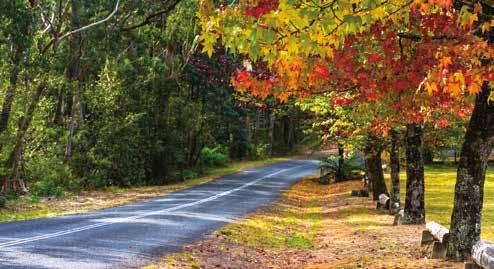
This edition we also have TTIA news on a raise to the minimum wage, benefiting the tree industry from the Fair Work Commission.
We are also announcing the winner of the Husqvarna pole saw and the new prize for the coming year.
Whilst l have your attention, l would just like to include mention of our Production Editor Arianna Lucini. Running arboricultural articles involves a huge amount of very focussed and detailed work. l find this far harder than doing tree work which in comparison is effortless. l wish to take this moment to thank Arianna from the bottom of my heart. Her brilliant mind, attention to detail and rapid ability to support what is right (she puts me on the straight and narrow too) really helps to keep me writing.
Also, l wish to thank you Kurt Quambusch, thank God you took time out from publishing and worked as a Groundie, as well as asked if Arb’s had a mag all those years ago.
The time has come to announce our lucky winner of our 2021-2022 AA Subscription prize, jump to page 6 to see who is taking home the Husqvarna 530iPT5S battery Pole Saw (with battery and charger). Plus we are to be presenting our new 2022-2023 AA Subscription prize, the Husquvarna 525PT52S Pole Saw valued at $1599.
Regards, Cassian Rupert Humphreys AA Sub-Editor AA
OCT/NOV
DEC/JAN
FEB/MAR
Publisher Kurt M. Quambusch
National Advertising Manager Sue Janjic sue@maynemedia.com.au (02) 8287 0651

Group Sales Manager KahChi Liew kahchi@maynemedia.com.au (02) 9452 4517
Subscriptions subscriptions@maynemedia.com.au 1300 764 688
Design Peter Cartledge art@maynemedia.com.au
ISSN 1327 1784
The Australian Arbor Age is a Bi-Monthly magazine published by Mayne Media Group Pty Ltd.
ACN 130 678 812
ABN 27 130 678 812 Postal: PO Box 489 DEE WHY NSW 2099 Australia Ph: 1300 76 4688 Int Ph: + 612 9452 4517 Int Fax: + 612 9452 5319 www.arborage.com.au
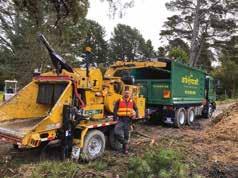



Copyright 2022
Mayne Media Group Pty Ltd. Material may not be reproduced or photocopied in any form without the written permission of the publisher. Mayne Media Group Pty Ltd. believes that all material is correct at the time of printing and will not be held liable for any incorrect information supplied within.
Cassian is a Merrist-woodian graduate (NCH-arb - 1991) qualified to Diploma level in Australia (09), his career commenced in Horticulture (85) and transitioned into Arboriculture (89). An experienced tree climber, instructor, arboriculturist, consultant, educator and writer, he has 30 years of experience. He sees his work as making a contribution to the Australian arboricultural profession.



Guy is a Master Arborist and Utility and Municipal Specialist, facilitating the co-existence of trees and people for the past 46 years. His company HistoricTreeCare.com manages the risk in veteran and historic trees by installing lightning and support systems, root invigoration, pruning and community education. Guy writes for tree care publications and works with the ANSI A300 Tree Care Standards committee in the US. He studies the science of arboriculture around the world.
PETER DUBIEZ
Peter is the CEO of Sydneybased Enviro Frontier (EF). EF utilises over 250 Tree Companies across Australia in managing tree works on behalf of its clients in the Insurance, Government and Facilities Management sectors. All jobs are managed using its proprietary technology platform (TreeManager) making it the leading data provider for the insurance and facility management industry. The company also operates in NZ, UK and Spain.
For almost 45 years Graeme has been based in the Dandenong Ranges East of Melbourne and become world leader in large tree removals.




Working as a production faller for alpine logging operations for three decades, expert witness, Investigator for WHS incidents and Lead Auditor are a sound foundation for him to assist with improving industry safety.

Leigh is an expert climbing arborist with a passion for tree conservation. He is a graduate from Merrist Wood College with a Diploma in countryside and environment and sub-Diploma in Arboriculture. Climbing and leading crews in the south of England, his work/ travels have taken him to Brisbane where he has developed a true passion for adventure tree climbing.
And the winner is… Peter Le Breton from Pillar Valley, NSW. When contacted about winning the prize, Peter said it put a smile on his face and reminded him that good things really happen. He sends a huge thanks to Husqvarna.
Peter has been operating as qualified Arborist from around 1980 after training at TAFE NSW - Pastow in Sydney.
Most of his work has been within National Parks, over a career spanning some 36 years, carrying out tree management assessments and works as required. Generally, evaluating defected trees within camping areas and reserves.
Most of his work these days has been within the Clarence Valley and the area north of Coffs Harbour with all aspects of the trade. Peter and his wife have taken on as much work as they can handle as Peter is about to turn 65 years old.
They recently purchased an Elevated Work Platform – a winner in Peter’s opinion! He also operates with a Hino 717, 300 series tipper, Red Roo stump grinders and a Brush Bandit 150 tree chipper – a “deadset beast” according to Peter. The Husqvarna is a welcome addition to his inventory and knows it will be put to good use by Le Breton Landscape Services, Trees and Stumps.


Thanks to the team at Husqvarna for their long-term support and we wish all our subscribers good luck for our next draw.
For more information regarding subscriptions, turn to page 72-73, call 1300 764 688 or subscribe online at www.arborage.com.au AA
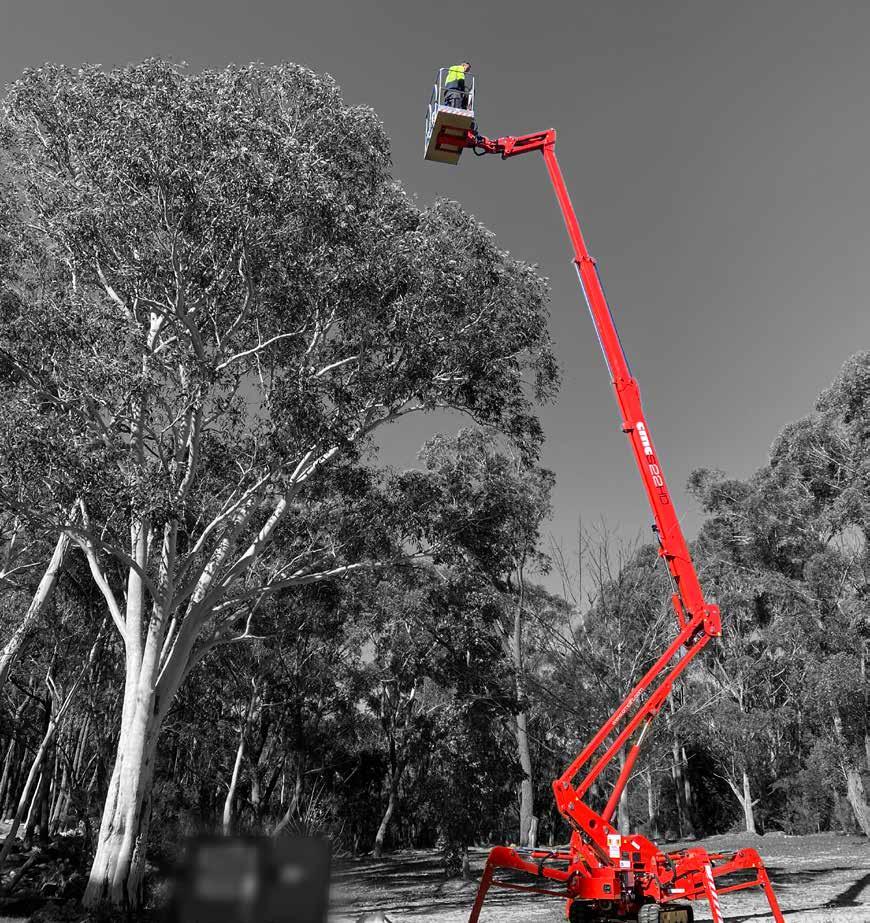
Aerial Access Australia has been a major supplier of elevated work platforms (EWPs) throughout Australia more than 25 years.
Aerial Access Australia has been a major supplier of elevated work platforms (EWPs) throughout Australia for 25+ years. With a practical and operational understanding of their application, the team of passionate industry experts have set out to change the way this innovative equipment
and machinery is manufactured and distributed for Australian businesses.
What sets Aerial Access apart is their operational experience and knowledge to provide safe and innovative equipment to the industry. The motivation has always been to provide safe, cost effective, reliable and fit for purpose equipment to get the job done.
As the business has grown, their ability to invest in the development of technology has helped them establish long term relationships with industry leaders and grow their range of equipment.
Aerial Access is an Australian family owned and operated business. They are a group of people who have worked for
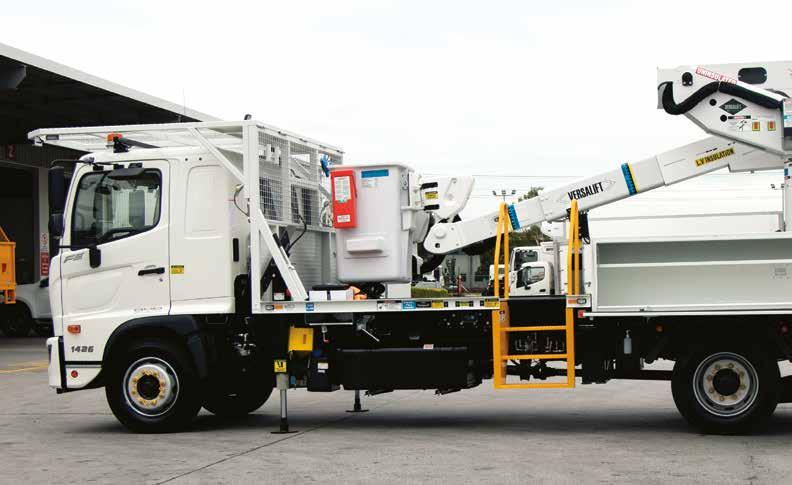
over 25 years in this industry to perfect and maintain extremely high levels of operational success. With a mission to support local communities, develop skills and training opportunities, and improve the safety of EWPs throughout Australia, Aerial Access is here to partner with businesses who want to elevate their operations with leading edge equipment.
Innovation is the core of this industry, and as Australia faces some very real environmental challenges over the coming years, the commitment of the Aerial Access team is to maintain a high level of investment in research and development, with a particular focus on environmental sustainability. From internal business policies to operational procedures that support the environmental and economic business objectives of their customers, Aerial Access sees the synergies between the operations and the requirement to protect and maintain the environment. Their equipment is designed to meet all industry standards and their sales commitment is to exceed expectations by understanding the
problem they are being expected to solve, while providing the best solutions for each individual customer.
The range is forever expanding as Aerial identify improvements and new technologies available within the industry, as well as develop their own, the speed to market of this controlled supply chain provides an unprecedented advantage to Australian consumers. The scale of Aerial Access and the ability to fast track and manage orders of varying sizes gives them the opportunity to respond quickly to market changes, ensuring they can meet budget and delivery timeframes for customers.
Aerial Access manager, Chris Sanderson, has the luxury of hands-on experience within this industry. While he acknowledges his start in the vegetation management business (on the tools) was a dynamic learning experience, he has seen it all and has always been interested in the technology available and the benefits EWPs provides stakeholders in every environment.
“We work on a significant scale, but our growth has been organic. It has taken 25 years of hands-on experience within this industry to really identify areas where our scale and size can make a difference to the EWP market to impact all Australians who risk their lives to keep us safe. By investing in new technology, by working alongside our R&D team and by increasing the safety and performance of this type of equipment, we can work with our customers to develop opportunities that enhance their operations.”
Chris is now responsible for working on the research and development of new equipment
that enhances the user experience, improves the operational performance, and delivers beyond minimum safety expectations and requirements. Based here in Australia, Chris and the Aerial Access team are on the ground with a service and parts division, working with each customer to determine the best outcomes and provide advice with the benefit of practical experience and backing from a highly motivated and skilled national team.
A safer way to do business impacts all Australians and our local communities. Aerial Access has a laser focus on safety and reliability that is prevalent throughout each stage of the manufacturing, sales and the aftersales journey.
To discuss your next build, get in touch with Chris, visit their websiteaerialaccess.com.au, or get in touch via email - sales@aerialaccess.com.au.
Alternatively, call the Aerial Access team on 1300 654 591.
For Spare Parts sales and enquiries email parts@aerialaccess.com.au
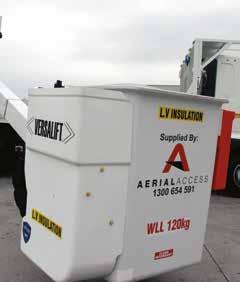

Aerial Access is currently looking for qualified diesel mechanics, heavy vehicle mechanics, auto-electricians and more. If you are interested in applying, please contact: apply@aerialaccess.com.au AA
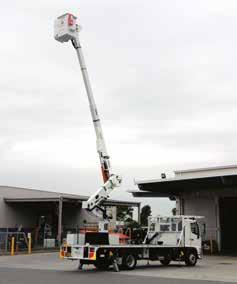
Tree failure and the processing of fallen trees is a considerable career focus for most arborists. In this edition we look into the topic of fallen trees which, left unto their nature, literally stand back up.
We may never see the tree fall in the forest. With the minute percentage of trees failing in the cities, suburbs, or in the rural landscape, to illustrate this point we are very lucky to see a tree fail in the wild.
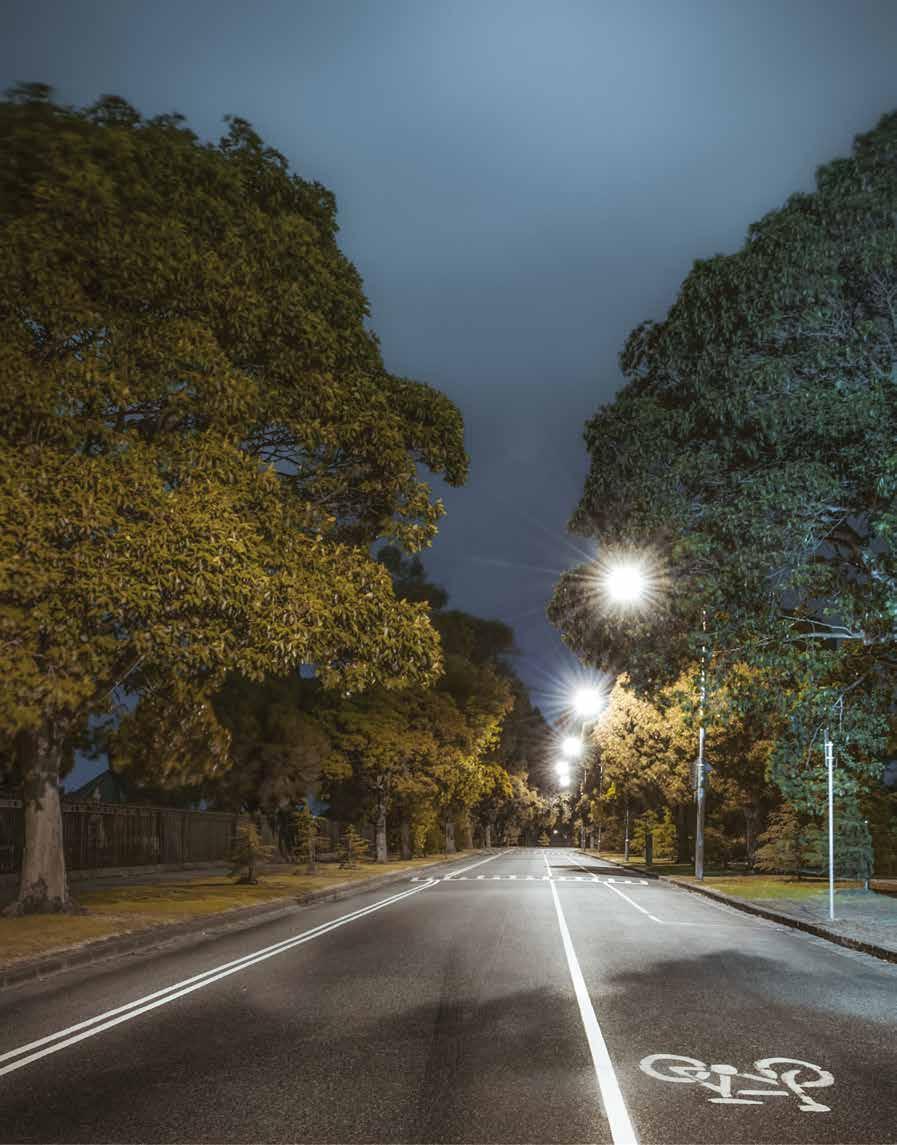
Though whilst bushwalking on a Bunya Mountains Forest path I was lucky enough to see the crown of a rainforest tree fail at around 20m in height.
Back in around 2004, on a still day, I was walking with my two sons, Euan and Fionn, (then aged 10 and 6), the head of the tree failed at around 1m in diameter, 15m long. This was preceded by three very loud cracks. We were around 60m away, after the first crack, I stopped dead in my tracks and told my boys to listen and watch. The second crack was around four seconds after the first, the third maybe two seconds after the second. The trunk exploded at the site of a cavity (based on later appraisal by binoculars, I reckoned the cavity was down to 10 per cent in wall thickness). I was not game to leave my kids alone on the path to assess the failure and approach closer due to the many live hangers. It’s one thing to risk self in natures rare ‘battle zones’,
another to leave our children on their own. When the cavity blew up shards of wood de-laminations, leaves and twigs rained down even to our feet, the head of the tree exploded and smashed through the forest like thunder. But the silence that followed made the experience all the more profound.
The closest I got to witnessing a whole tree failure involved a Black butt – Eucalyptus pilularis, whilst working the Energex VTA Program (proactive tree risk assessment) in around 2011. The tree had failed only hours before I arrived (due to Canker Syndrome), within 2m of ground level leaving a de-laminated 2m high ripped shard (Ref: AA past article of mine - 2012 - Canker Syndrome). This was for me an ominous experience, as I was appraising the tree, actually walking on the tree’s downed 1.5m trunk I received a phone call from a colleague, announcing the death of a very well loved and highly respected arborist, who had just died after being struck by a tree.
I have known and even witnessed arborists fall. In 1991 I saw a trainee climber (Merrist Wood College, UK) fall from 15m, almost on top of me (I leapt out of the way just in time), had I leapt to the right instead
of backwards, I could have caught his lifeline and arrested his fall. In 1996 I witnessed a past employee and friend take an 8m fall, bouncing around the tree’s crown, landing on his feet back to the trunk (his femur broke through his leg and trousers). Though when our time is not up, we are almost bullet proof, at times we humans are very fragile compared to trees.
I have never actually witnessed live a whole tree fail (root ball and all), with experience of the aftermath of a hurricane (Surrey UK 1989), cyclones in Queensland* and Vanuatu (Cyclone Pam 2015), as with many other arborists tree failure has been a considerable career focus.
“The 2008 Gap supercell storm and its effect on the Brisbane urban forest was recorded by me in a 2008 Energex report and 2009 AA article. It took experience of the Energex VTA program, appraising whole tree populations (central-west Brisbane to Tin Can Bay), as well as waking up to the QTRA drive (we now also have TRAQ and VALID) for recognising trees and tree failure in the context of risk (in a future article I will cover the negative on that), I take the tree failure story with an open mind. Moreover,




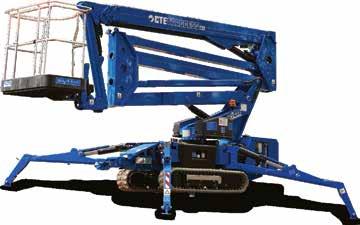
I recognise that tree failure is actually a rare event, it’s the mainstream media which dramatises/misleads true observation and experience, Covid-19, say no more.
So what does this narrative have to do with trees standing up? Maybe the depth of value I have for trees is somewhat grandiose, but in the same way I value the fallen amongst humans (arborists, soldiers, firemen, nurses etc), I value the fallen amongst trees. It was my study of Mattheck’s Body Language of Trees and the development of my educational package (Tree Culture Course 2004-2012) as well as working the VTA program, that led me to awaken to the magic of the Harp Trees, studying tree populations on the Energex HV network enabled me to find a number of harp specimens in the field.
Indeed, many of our fallen tree brothers and sisters left unto their nature literally stand back up. This reality makes a perfect analogy of the fallen human, we all love the child and action hero/heroine that gets back up again,
not to mention the songs – an old Aussie footy favourite – ‘I get knocked down, but I get up again, you’re never going to keep me down’ (ref: Chumbawamba - UK band).

So why do we arborists race out with our chainsaws and chippers to process our fallen green mates? It’s like we think we’re the action heroes, saving the day from a downed tree? Surely, wouldn’t it be better to spend the energy in helping the tree to stand back up again. Certainly, in open space, in parks and in many private situations we can support and encourage trees to stand back up. With ‘carbon credits’ in mind it would be very worthy to value the body of standing trees to help give a dollar price on fallen ones, I suspect there is or should be a dollar rate per square inch of live sapwood (less for heartwood?) to help value the downed tree. We know well the body of the standing tree, the trunk generally central to the crown, with optimisation in mind ideally with a field pasture or paddock crown, all evenly balanced and conditioned for load. This is the vision we generally hold to, when we think of trees.
So in nature what happens when a tree falls following rootball failure?

To better understand the optimisation of downed trees lets first consider the process

“When the cavity blew up shards of wood de-laminations, leaves and twigs rained down even to our feet.”Fig. 2: Harp trees from ‘Stupsi Explains the Tree’ – Prof Claus Mattheck. Fig. 3: Crystal Waters, a classic harp tree.
The MHP line of trailer-mounted boom lifts offers three models built to suit a wide range of applications with maximum working heights of 12.6m to 14.8m and maximum platform capacities of 200kg to 227kg. These rugged and reliable machines are perfect for those who work at multiple jobsites and need the portability a trailer-mounted boom lift provides. Add to that the automatic self-leveling hydraulic stabilizers and these versatile boom lifts are the ideal machine for arboreal tasks.

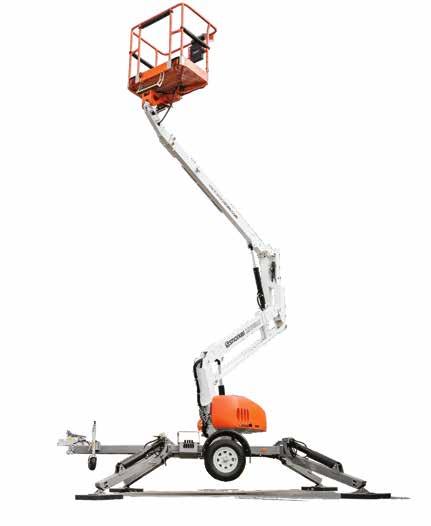
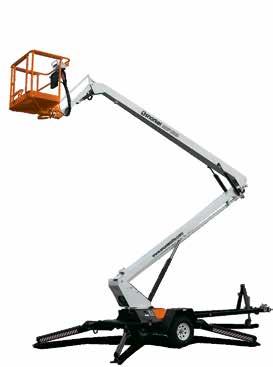

of rootball failure. To understand the rootball failure process as Mattheck describes it, I have found a no better considered perspective on this topic to explain what I have seen/see in nature. However, on Mattheck, I am aware of a current almost religious movement in arboriculture where mathematical impassioned rhetoric (the kind of rhetoric that distracts, confuses and belittles) is being used to disprove what I (and my brothers/sisters) see as natural truth (this is a hot topic within the five eyes of Arboriculture). Mattheck has very much been in the firing line on this, my attitude is –if I repetitively see a human hypothesis* be validated in nature, then for me it stands as
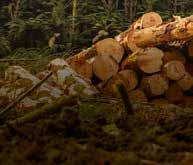
Fig. 4 ref: historically Figs. 62/63 (past AA article), Gap Storm Report /AA article 2008/2009. 1. Wind, 2. Tension root slippage or shearing, 3. Soil crack on the windward side, 4. Shear slippage at the root plate, 5. Wind throw.
Fig. 5: Flashforward to Ohio 2013, I can add that having seen the legend Ken James do a root crown excavation on a tree at Biomechanics week (Fig. 4), that in the same way trees step down force via oscillating their crowns, it is very likely that a form of oscillation is going on below ground too. Tree biomechanics has much to teach us. Ken’s sensors were picking up on considerable movement in the root-plate just from a person walking on the exposed roots.

the ultimate proof. I seldom seek permission to believe something from the collective (having heard Shigo’s call – I am not a sheep who stands in line based on say so). Regardless of the source, first I must see it for myself, if it makes sense on the level of the heart then I am a follower (I less trust mind which is often ego led). If we are honest, we own that good science is about observation which is effortlessly demonstrated in nature. *As captured in my 2008 Energex Gap Storm report turned 2009 AA article, I studied 85 root ball failures immediately after the supercell storm event (and reading The Face of Failure). I repetitively saw evidence of the process described by Matteck for myself.
The following was covered by Mattheck in his last 2004 Brisbane, Melbourne and Sydney conferences. Mattheck describes trees as having two distinct types of root plate, this is a reflection of the impact of compressive and tensile load on trees, largely caused by gravity and wind – the tension root plate and the shear root plate.


Fig. 4 ref: historically Figs. 62/63 (past AA article), with the following paragraph taken from my Gap Storm Report/AA article 2008/2009. Mattheck has detailed five general factors of failure which leads to root ball failure.
“The cause of root ball failure as with the cause of crown failure is seldom









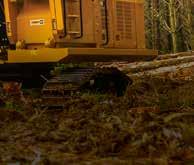






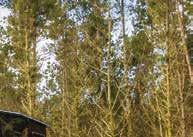












Fig. 6: Another classic harp tree that I used to ride past every day in my time I worked as the Technical Officer for the Queensland Arboricultural Association in 2014. Going by the footprint of this tree, I would suggest that this Forest red gum – Eucalyptus tereticornis has been optimising in its fallen position for some years. On reflection, this is a tree I plan to return to, to measure. It would be interesting to measure the diameter of the original trunk, to measure the diameters of the optimised upright limbs (either optimised past lateral limbs, or epicormic shoots now endocormic in their nature – in my mind this amounts to the same with currency in mind), as well as measure the footprint of the now root crown. Not that I could bring myself to ‘fell’ such a survivor, but it would also be interesting to dissect such a specimen and count the rings of the original trunk in relation to the replacement ‘leaders’.
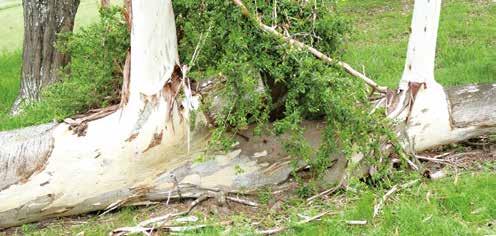
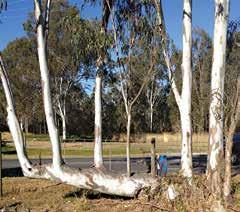
Fig. 7-9: I originally found this remarkable three stemmed harp tree in Highvale Qld whilst working the Energex VTA Program for ETS in around 2008. I actually went back to the region to try to find the tree for an update and to take some high-resolution pictures, having lost the originals off a dead hard drive, these pics I poached of a PowerPoint of mine, but the tree’s story has to be told.
Fig. 6
attributed to one factor; in a high wind event a structure will either transmute applied force through its body into the ground or it will fail. Trees as living structures are subject to considerable variation with their biomechanical status, this is based on environmental parameters which are as varied. We know via the science of Shigo and Mattheck that the threads of biochemistry run throughout the woody framework that is the tree, that successful mechanics (regardless of mechanical constraint or defect) are attributed to plant
vitality. Regarding trees with poor vitality, or in a storm event, failure occurs generally at the weakest link in a structure, or where the lever arm (height) is out of proportion in relation to the foundation. Often described as poor taper, or where hot spots leading to ‘whipping’ of canopies occurs. Whether a tree’s structure is upper crown to fork, or upper crown to root plate, or root ball, trees are most successful where there is even taper and an expansive root system, which has been unimpaired by hard landscape or development. The diagram above depicts the shear and tensile root plates. My experience and understanding of root plate failure and failed trees is based on and validated by Mattheck’s research. The failure mode can be a variety of factors which are determined by the individual root architecture of the tree.”
I personally saw Mattheck present on this in the Brisbane conference 2004 (his second downunder tour). Incidentally I was given a ticket of attendance to Mattheck’s first VTA tour of Australia 2000 by winning in the hot (tree) pix section of AA that year. My entry that won that year was a burl in a Poinciana so large (and dense, I could not climb through it) it took up the whole tree’s crown.
In my 2008 Gap Storm report I went on to give examples of a series of rootball failures as a comparison to the failure patterns discussed in Mattheck’s book ‘The Face of Failure’ – that past AA article can be seen via this link – https://tinyurl.com/ GapStormReport
Case Study 1 - A Highvale Gum TreeEnergex VTA Program - 2008
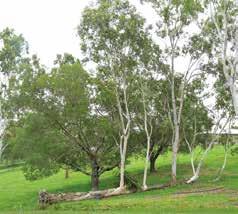
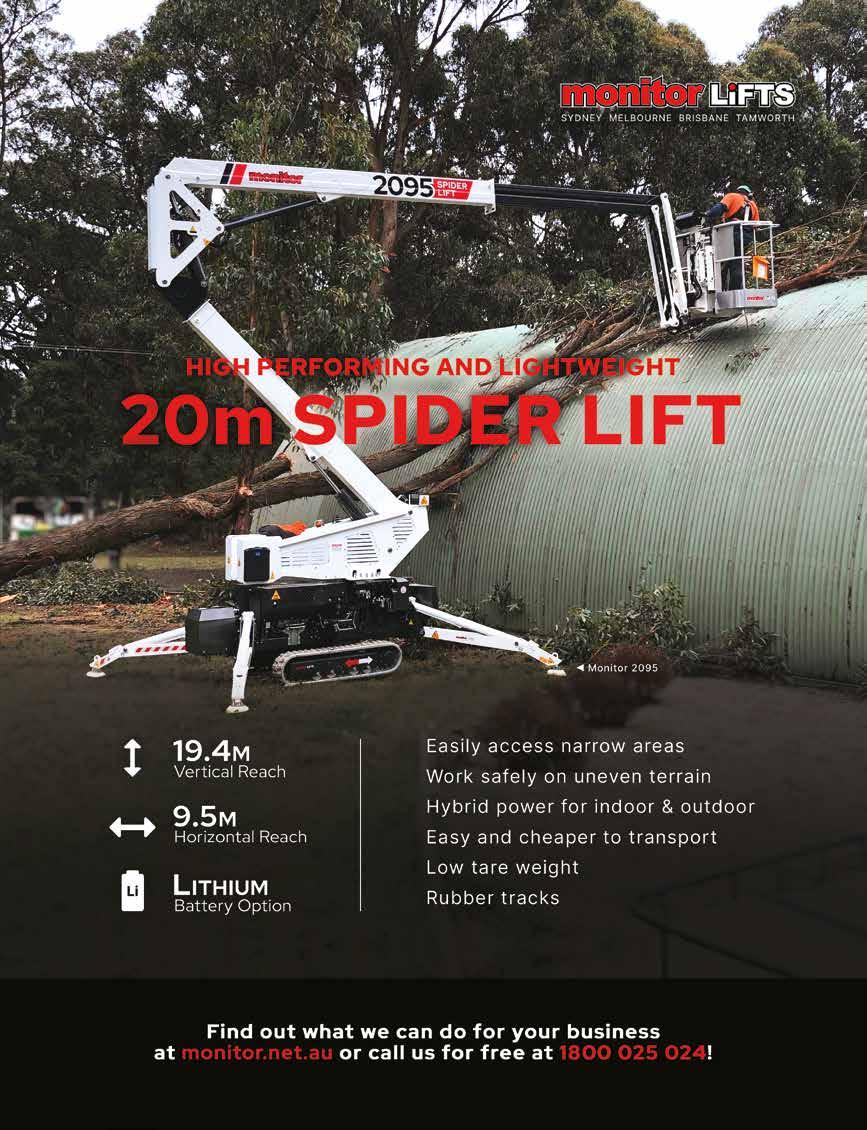
Fig. 8 Fig.
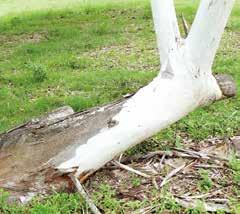

vitality of the upright ‘harp stems’ it seems highly implausible that these uprights are not drawing their own water from the ground. Regardless of the sustainability of this ‘downed’ tree, from a structural or biological perspective, this perhaps can be seen as a form of previously unrecorded optimisation in a harp tree.
Back in April 2013 there was the very major failure of a historic oak tree in Pontfadog Wales. The tree is recognised to have been between 1,200 and 1,600 years old, the short tree (retrenched by people and time) stood in a heavily compacted field and remnant hedgerow/dry stone wall.
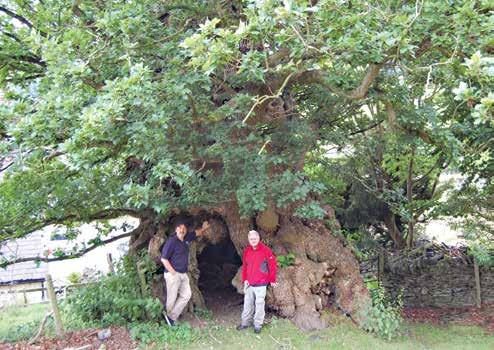
This tree caught global attention amongst arborists, conservationists and tree enthusiasts, ancient trees an interest that had gained momentum post the mid-2000s. A movement that celebrates ancient trees. For us Aussies this movement started in 2008 with the ISAAC national conferences (ENSPEC Director and past President, Craig Hallum, I commend you for that line up). I attended the Brisbane conference and was gifted to have close contact with ancient tree enthusiasts and presenters, arborist Andrew Cowan, conservationist Jill Butler, ancient tree expert Ted Green (since knighted for his life’s work) and the legendary Dr. David Lonsdale.
Following the conference, I lined up country accommodation and took this merry band of tree lovers on a tour of trees in the D’Aguilar range S. E. Queensland.
Britain is regarded as having more remnant ancient trees than Europe, probably mostly Oak trees (Quercus spp), though the oldest, also native, are the coniferous Yew trees (comparable to our native Brown pine trees – Podocarpus elatus.
Back to the Pondfadog Oak tree – though since falling, a little too close to private property (the roof line of a home), perhaps for some, for I, a light pruning back from guttering would have sufficed as sufficient reason to (have at least tried to) keep the living chunk of ancient history. With consideration of the interest and support the Tree Hunter generated I believe that as a ‘phoenix’ the tree could have been supported (with funds raised) into living on.
Certainly, as an arboricultural project, the attempt would have been very worthy. Though my observations and suggestions were of no use to this ancient, they led Mr McBride to gain support to cover the root ball of another fallen old-timer. I still reference saving the Pontfadog Oak tree as an example of the capacity for modern arboriculture. For those serious students of Arboriculture, I encourage you to carefully study the posts on Rob McBrides FB pages, as an ancient tree conservationist he, like Jill Butler and Ted Green of the Ancient Tree
Forum, is worth following. Enthusiasts such as the Tree Hunter and those involved in the ATF are doing more for historic trees than most arboriculturists (though big name UK Arb’s are certainly involved).
We in arboriculture and the Land Care professions/industries (ref: ‘i-culture LandCare via Vegetation Management’ AA June/July 2022) are driven to fell and process downed trees, often without second consideration. Yet as Shigo states (ref: Modern Arboriculture, the cambium and parenchyma and the capacity of differentiation) through paying attention to trees (for ourselves), we can act on the capacity of trees via their cambium (parenchyma cells) to differentiate into a variety of growths, including roots. Many trees from all round the world grow roots into their own trunks, when it comes to ‘specialised’ optimisation down-under, rooting from the cambium back into inner decaying heartwood (part of the Magic of many Australian species that make up the family Myrtaceae) is well recognised.
So, what if we were to crawl inside the open cavity/root crown of fallen ancients like this and to treat the tree to produce roots. Expose the ‘internal’ cambium* via exposing pockets of decayed heart wood, to lightly abraid and treat the cambium with root hormone product (horticulture has many such products), then pack with moss, humus and leaf litter. I suspect we only need to set up a few ‘trigger points’ for root production, we may assist with a kick start, the trees
Fig. 10: The Pontfadog oak tree was, I believe, a classic example of a fallen tree that could have been saved with modern arboricultural support (or maybe more old school horticultural support). This conclusion is based on my study of the many pictures/posts of the tree visible via The UK Tree Hunters FB page Rob McBride is another ancient tree enthusiast - https://tinyurl.com/yckxnfr3
Principally via the study of the tree’s vitality (capacity to support new root growth due to energy reserves) I see a great opportunity for arboriculture or Conservation Arboriculture in action.
Fig. 11: The downed legend herself, the millennium plus old Pontfadog Oak tree - April 2013.
Fig. 12: When we consider the abundant production of wound wood (and burls?), we know that the cambium is being driven by good vitality, this means stored energy and solid energy production by the tree’s remnant crown.
will do the work. I know via study of the Tree Hunters page that there was only one major root (20cm diameter?) left, still attached to the tree. We could treat this the same way (as above) but also wrap it in a sock of hessian (a preventative practice for sunlight damage/ dehydration on transplant trees down under) and rebury it. In the case of top end support via the Soil Food Web Institute (AUS and NZ, they tried to establish a branch in the UK but I believe it failed) a compost tea irrigation system could be established to help keep up the essential associate microbiology and water to support root generation. *I have personally recorded the generation of callus/ woundwood on the inside of tree trunks and on the inside of wood splinters - Ref: ‘A voyage into the Symplast Part 1’ AA 2011. In truth I would be surprised if this Welsh ancient did not already have internal roots drawing on ‘humus’ from within.
Yes, a tree health care program would be necessary, to keep up the air, water and biologically active carbon (humus), but
considering the amount of support being generated for ancient trees I am sure funding to proactively help keep them alive is very viable. Proactive Arboriculture, now that’s a dream, the purpose of this article is to seed the passion for future arborists to make the change, though such will take better arb salesmen than I.
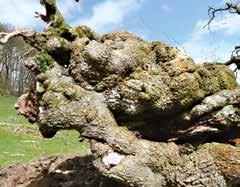

As part of my personal quest to help create the change, 10 years ago (close to the time of the Pontfadog ancient tree failure), I stood aside from mainstream Arboriculture and pursued the next level with SFI and Plant Health Care principles applied to organic food production (understandably there is more money set aside for food plants than trees). PHC or rather Tree Health Care is poorly supported in Australia. In parts of the United States and in Germany PHC is much better supported as a proactive form of arboriculture.
Bandit Mobile Service trucks are launching soon. All part of our promise to deliver outstanding customer support and backup across Australia. We’re here to support your success. More to come!

Fig.
To these ends in 2015 I partnered with a Social Justice organisation, with project proposals lined up in Vanuatu and Africa. Using my operational model there were many other project proposals I was not directly involved with lined up throughout the Pacific region (the Covid drama has stalled all such projects). It was on a business trip to Vanuatu in 2017 that I discovered this incredible specimen - The 1974 Cyclone Zoe Rain tree – Samanea saman formally Albizia. One of the most interesting arboricultural studies of my career.
Yet though flattened, rather than lie down to die she stood back up, making a full recovery. Going by this vitality (pictured 2017) I wonder if her lifespan has even been reduced.
Since my study of examples of harp trees, prompted by the failure/loss of the famous Welsh Pontfadog oak, I have been very
focussed on this topic and maintain that arborists could save many if not most trees that fail due to rootball failure, or worse, even shearing at the root crown (if sufficient roots are left connecting to ground). In my observation of fallen tree survivors, or harp trees, in the case of trees with good vigour and good vitality (Shigo’s definitions please), I believe that as little as 10 per cent of the tree’s root system remained attached to ground is enough to get a decked tree to stand back up. Especially if we cultivate the area of soil it is attached to, though in truth the cultivation of fallen trees to enable sufficient root ‘re’-generation, to help a tree to fully optimise on its downed situation (as discussed in case study #3) is to also involve horticultural grafting techniques.
This I intend to cover in Part Two of this article. But what we have to guide us on are legend tree survivors – such as the Cyclone Zoe Rain
Fig.
Fig. 13: Port Vila Market place Vanuatu 2017 - the 1974 Cyclone Zoe survivor - a classic Rain Tree, native to Central and South America. A popular introduction to Southeast Asia, Melanesia, the Pacific Islands and far North Australia. I personally gained a valuable insight to the robustness of this species consulting in New Guinea and Vanuatu, 2011 and 2017.



Fig. 14: This Port Vila - Vanuatu marketplace tree got felled 48 years ago by Cyclone Zoe. Yet here she is in all her glory, a tree that stood back up.
Fig. 15: Almost complete occlusion of her up-ended root plate, this body language to me is an indicator of shorn tension roots and a shorn root plate (indicative by the flatness of the root crown underside). Had this been a root ball failure I suspect we would have seen the remnant upended ‘hedgehog’ of roots, though perhaps in 40 years that evidence was compartmentalised.
Fig. 16: Shigo was the first to tell us that parenchyma tissue has the capacity to differentiate into a range of forms - callus (into wound wood), roots, shoots and even (in the case of cauliflorous tree species) flowers.
tree, that clearly have done this for themselves. This tree has almost completely occluded the underside of its upended root-plate (ref: Fig. 2), I had wanted to pull back the tarp, but did not wish to disturb the local marketeers, without the NiVan language (I was travelling alone at this point) the
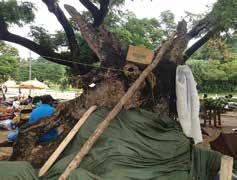

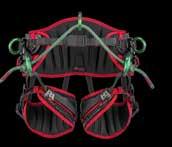

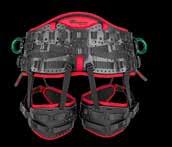


last thing I wanted was to insult the locals. As with my experience of the people of Papua New Guinea, that is far from a good idea, respect for the locals is paramount.
Experience of excitingly photographing this tree (I could not contain myself) was enough to inspire the sensitive women of the marketplace. Seeing my love for the tree I was given a number of smiles of silent understanding, sometimes a lack of language is a great gift.
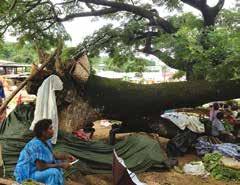

The Rain tree is very likely to have generated a new root system out of her old trunk at the point of touching the ground (ref: Fig. 17), this would be well validated by checking the ‘buttressing’ footprint (swelling and growth striations) at ground level where the resting trunk is ‘buried’. Not willing to impose on the locals I kept my
distance. In truth I have always intended to return on a non-market day. The fact that the tree occluded her exposed root plate/ root ball and in all likelihood grew roots out of her trunk is a testament to harp trees as consummate survivors. Though in my study of harp trees it’s only the trees with the really great guns – optimal vigour (genetic stock) and vitality (health) that achieve such goals. Even with the tarp obscuring the view I can see by the tree’s body language that she transitioned back up with as little as 10 per cent connectivity to mother earth.
Ref: Fig. 13-14, based on Visual Tree Assessment (Ref: Mattheck), it’s clear that after failing this tree reiterated/reorientated its crown by growing its existing horizontal branches into upright stems, as well as ‘folding’ its canopy back. The tree’s
Fig. 18
body was made up of two trunks (one now touching the ground) with a U-fork. Going by Fig. 17 the occluded top was either damaged at point of failure or removed (cut).
On the underside of the tree’s crown, I think it likely that new roots have generated from the trunk in contact with the soil, as well as the upended root crown. The brilliant truth of trees is that they never lie. Whereas we humans can and often do lie about our achievements, when it comes to trees their body language is the ultimate record.
original
“My call is that in the name of arboriculture (or maybe conservation arboriculture) we push past the limits of our arboricultural thinking (education) and help the trees to stand back up.”
From its unique doubly secure interlocking anchor bollard, to the highly efficient oversized ball bearings, this is a block with a difference.
– Compact, lightweight
– Double security at the anchor bollard
– Ideal for both everyday rigging and winch operations
– Hollow axle facilitates multiple configurations
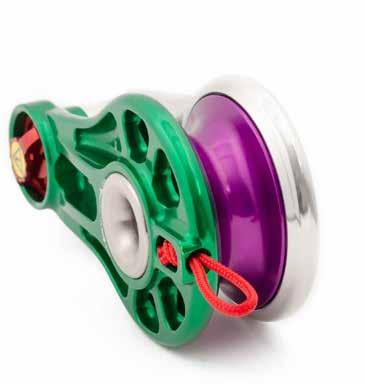
– Hauling loop simplifies hauling, transfer and storage
– Fairleads flairs help maintain efficiency even in suboptimal set up
What validates such success is that this tree achieved such a feat on its own. I would think that this occurred before the area was a marketplace. How long this has been a marketplace I am uncertain, though I find it hard to imagine a tree achieving such adaption in such a heavily compacted and desertified area. It’s actually miracle-enough to see a tree sustaining such vitality in such a desert, especially when it was historically flattened. Imagine a human being beaten in the order of 80-90 per cent of his life and then unassisted getting up and walking away, I do not think so. Trees are far tougher.
In honour of this tree and as a symbol of the cyclone veterans of Vanuatu, that’s the people and trees, I have always wanted to carry out a future restoration project (this was a proposal to a Port Vila government minister) to improve the trees longevity, by restoring the heavily compacted soil. I had since had the idea to sponsor the building of a deck over the trees reconditioned root zone for the marketeers. Part of this as a

Fig. 20
project, is to involve investigation to gain a better idea of the trees’ optimisation below ground. As with consideration of the Pontfadog oak if trees such as the Rain tree are making this kind of adaptation with only two points of soil contact, imagine if we were to set up multiple points (via cambial abrasion, root hormone treatment and the establishment of bound moss patches to generate roots). I first awakened to this as an arboricultural strategy (via my earlier horticultural training) after doing exactly the above on a young, vandalised fig tree (I planted in a Brisbane park - 1991) back in 1993.
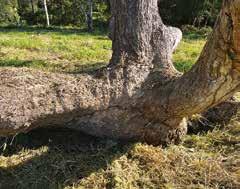

Though I see this Broad leaved Apple gum tree as a prime example of an optimising harp tree, as far as this discourse is concerned, I have already covered a solid chunk on the capacity of trees to stand back up. What is exciting for me with this specimen is the opportunity to experiment on a harp tree and to record my observations. This I will discuss in Part 2.
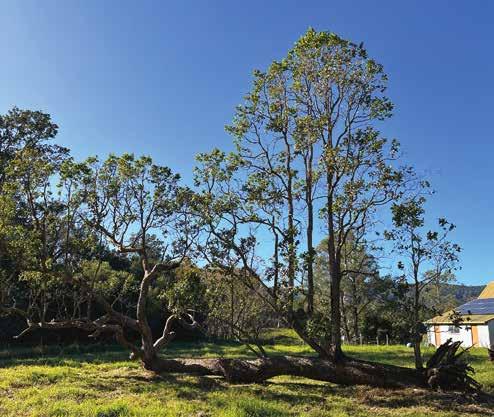
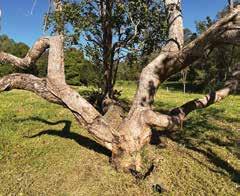
In a future article I will carry out some partially invasive works to uncover what is actually going on below ground.
Fig. 21
Fig. 22
Fig. 21-23: Looking at what was the upper crown on this tree when it was standing (the northernmost side) we can see a little under half the remnant crown remaining. It looks like the top was shorn off (probably at the time of failure) and has since occluded. Over time the lying trunk has thickened on the northern end of the tree and the ‘upper crown’ has likewise laid down wood. Going by the tree’s body language I am inclined to believe that the tree has rooted into the ground at this point. On the southern end only two roots have visibly kept going providing water and elements to help support the generation of wood (via photosynthesis from the remnant and replacement canopy) for what was the downed upper crown.
Fig. 23: Reading into the tree’s body language at this point and seeing the thickened now vertical limbs and the thickened ‘buttressed’ footprint at ground level, the likelihood of rooting at this point is high.
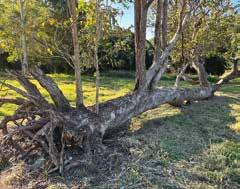
Fig. 24: Moving southwards down the fallen trunk we can see signs of epicormic/endocormic transition, particularly at the mid cluster of branches, the old horizontal limb has grown shoots, now thickening well optimised vertical stems since the tree fell. Though likewise two epi/endo limbs have grown as buds out of the tree’s trunk directly above the root crown.
Fig. 23
Fig. 24
You begin each day before dawn with a drive and determination to do more than the day before. When you move at this pace, you know to do more you need equipment that is made for more. That’s why our equipment is built from the ground up to meet your needs, delivering:
More Power and Production
Lower Operating Costs Ease of Maintenance Greater Longevity and Resale Value
If you’re ready to operate equipment that’s made to keep pace with you, then we invite you to contact the authorized dealer in your area of the world. To learn more about our equipment go to www.morbark.com

Morbark

NSW/VIC: Global Machinery Sales 1300 072 926 globalmachinerysales.com.au
QLD: Allclass Construction Equipment 1300 255 252 allclass.com.au
WA: Westco Equipment +61 (8) 9258 9333 westcoequipment.com.au
NZ: Commercial Outdoor Machinery 0800 26 66 88 commercialoutdoormachinery.co.nz
Boxer
NSW/VIC: Global Machinery Sales 1300 072 926 globalmachinerysales.com.au
QLD: Greenstar Equipment 1300767589 greenstarequip.com.au
WA: Westco Equipment +61 (8) 9258 9333 westcoequipment.com.au
NZ: Commercial Outdoor Machinery 0800 26 66 88 commercialoutdoormachinery.co.nz


NSW/VIC: Global Machinery Sales 1300 072 926 globalmachinerysales.com.au
QLD: Greenstar Equipment 1300767589 greenstarequip.com.au
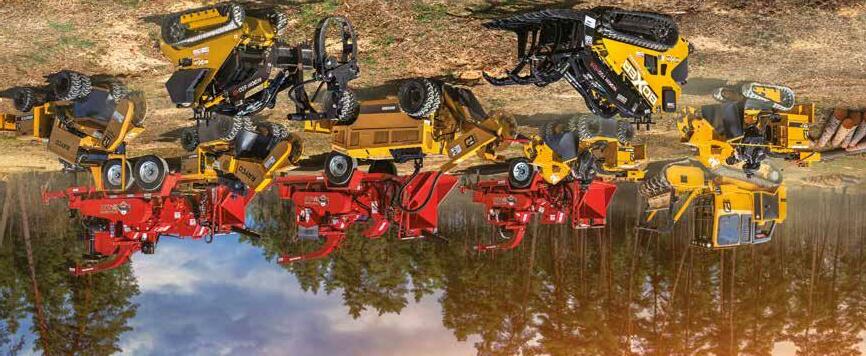
Fig. 25: Study of the tree’s exposed root crown is of interest, as we can see that this was a root ball failure, the soil root ball has since been washed off, leaving the root plate exposed like a hedgehog. Likewise, we can determine that only 10-20 per cent of the tree’s root system has remained attached. Gum trees have evolved to deal with root loss and optimisation via erosion, though they rapidly die with root loss through being buried, this is the ‘development site’ curse.
Fig. 26: On the western side we can see the swelling in the tree’s trunk (growth striations with wood expansion) where the root is buttressing into the stem and expanding into the soil, going by the sizable footprint it’s likely that a number of roots have grown out of this remnant root. Also, we can consider an original root surviving in the same way, directly under the remnant failed root ball. I suggest that three roots would make up roughly 20 per cent of the tree’s original south facing root system.
Fig. 27: Likewise on the trees eastern side we can see a major root connecting the ground and buttress/trunk, this has grown significantly following the trees falling.
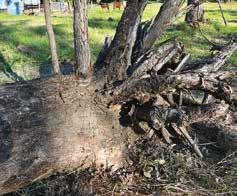
Fig. 28: Study of this photograph supports observation, measurements and some interesting information. I measured the base of the tree at 70cm diameter (red mark), the midpoint at 51cm diameter (blue mark) and the upper trunk at 69cm (red mark). Between the first adapted limb and root crown the tree has a steady taper heading north to the base of the said limb. At the midpoint the trunk drops down in diameter significantly, I suspect that the lower trunk has kept laying down wood, whereas the mid trunk is the same diameter at the time of failure. The diameter of the tree at the upper crown, the point I suspect roots were generated into earth is almost as great as the base. This validates the laying down of wood (akin to the remnant roots/ buttress), indicating two major attachment points to the soil. Note – I brush cut around the fallen tree to reveal the tree’s body for this case study.
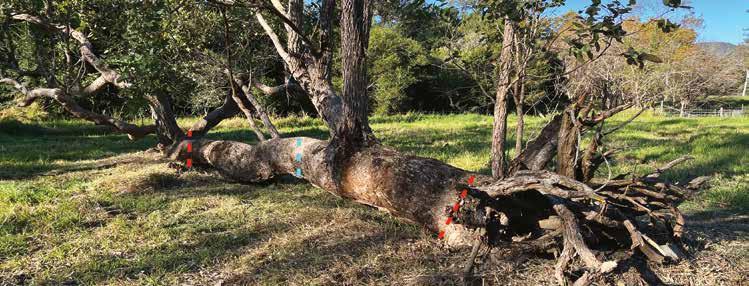
For inspiring me in this – the Pontfadog oak - Wales I salute you. Incidentally, though I grew up in Devon, my surname Humphreys is Welsh. I come from a line of Welshmen I would have loved to have known.
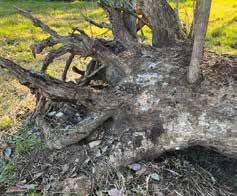
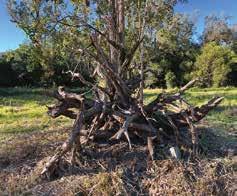
In conclusion of this feature article, based on the established scientific record given us by Shigo and Mattheck, given us by the many examples of nature that a number of arborists (few scientists) see day in day out, my call is that in the name of arboriculture (or maybe conservation arboriculture) we push past the limits of our arboricultural thinking (education) and help the trees to stand back up. This I believe we can effortlessly do via the old school horticultural grafting
practises the oldest of us grew up with. With workshops in mind, grafting practises for root generation and cambial growth (i.e. ring barked trees) should be on the association bucket list. Also, with budget in mind consider the cost of destroying/processing a fallen tree by chainsaw/chipper and extend that financial investment to help a tree stand back up.
I had no idea when l committed to arboriculture aged 22, that l would find so much more in the field beyond my initial education, or that l would be destined to write. With thanks and praise to AA for giving me the platform.
Humphreys AAFig. 25
Fig. 26 Fig. 27

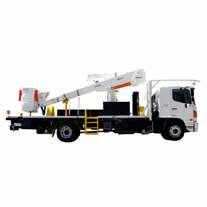




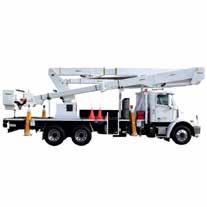

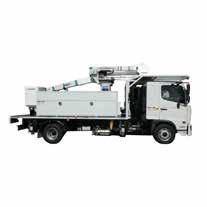

This issue we talk to Glen Keedle from All Round Tree & Garden Care about business growth – how to go from a one-man business to a team of arborists.
Can you share a little about your background prior to starting All Round Tree & Garden Care?
When I left school, I worked for many businesses general labouring and worked for several years for a local tree company. After some time I completed a Certificate IV in OHS and became a Workplace Health & Safety Officer for several years at a pipe manufacturing company. This was a very interesting and challenging position – writing and implementing SWMS and Risk Assessments.
What was it that lead you to the tree management industry?
When the Global Financial Crisis hit in 2008 I was made redundant from my role as a Workplace Health & Safety Officer. That’s when I went back to my Tree Care
qualifications. In 2009 I started my own tree removal business ‘All Round Tree & Garden Care’ in the Illawarra. I started off with one chainsaw, one ute and one trailer advertised in my local papers.
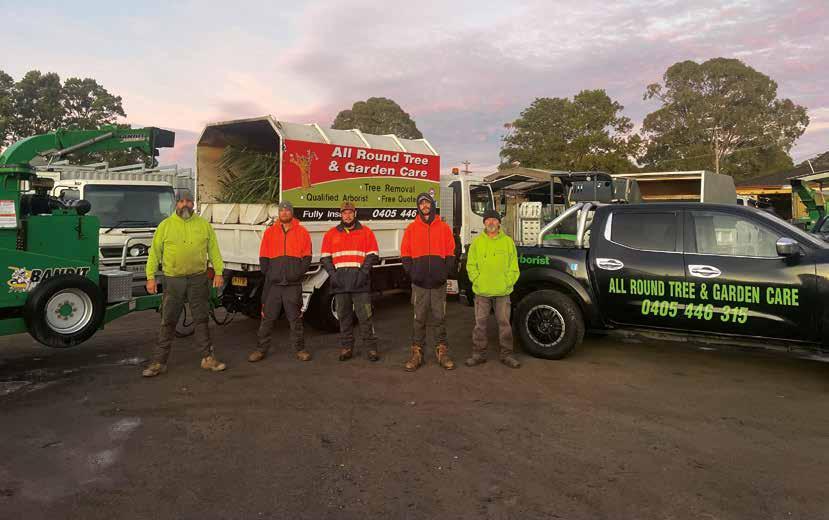
How long have you now been in the industry and how has your business changed in this time?
I have been in the industry for around 20 years and have owned my own business for 13 years. During this time, I have seen phenomenal changes in workplace safety. Having a safety background, it was just a matter of learning the industry and how to focus my knowledge on implementing and writing all my own safety material and, as we all know how dangerous this industry can be, making sure we all go home at the end of the day.
As my business grew, I had to update my equipment and keep up to date with the latest machinery and technology. This has helped with productivity, allowing us to take on more jobs. An example is lowering devices, when I first started there were only wraps around trees, we now have porta wraps, GRCS, and many friction devices.
Workplace safety has also changed over time. In my early days they only had prussic ropes for climbing and now there are many different options to climb with like rope runners, SRT, spider jacks and many more.
During this growth phase, myself and three other employees have obtained a Certificate III in Arboriculture. I also ensure employees have many other qualifications relevant to the industry such as operating chainsaws,

working at heights, first aid certificate, heavy vehicle license, etc.
One of the customers I purposely targeted was work with the Department of Education, due to the extent of the number of schools they manage. I have been a contractor for the Department of Education since 2014 and look after around 14 Schools in the Illawarra.
I am also a contractor for the State Emergency Services (SES) since 2015 this has enabled me to obtain emergency work. This has led to a great working relationship with Enviro Frontier, which has further increased my work opportunities.

What have been the biggest challenges for you in growing your business?
One main challenge in growing the business is being able to source skilled workers, which is why we place great emphasis on putting employees through training courses to increase their knowledge and skill levels in the arboriculture industry.


A second challenge is trying to foresee growth to be able to purchase new equipment which comes with financial risks.
What have you enjoyed most about the growth of your business?
I have taken an immense amount of pride watching my self-managed business grow and expand. I started this business by myself, with one chainsaw, ute and trailer within two years I saved up enough money
to purchase an old truck and chipper which allowed me to grow and slowly expand. Within the two years following I was able to purchase a new truck and Bandit chipper. Coming to 2022 we have currently two trucks, two chippers, a loader, a cherry picker and have on staff eight employees, three of those level 3 Arborist and one level 3 training arborist in his second year. We are also looking for our next candidate to undergo industry training.
The safety culture and professionalism we have formed over the years has been another enjoyable aspect of our business growth we have had over 13 years. We had four to five lost time injuries, which have been minor, and are currently around several thousand hours with no lost time injuries.
Is there anything you would do differently if you could do?
I don’t think there is a lot I would do differently.
What advice have you got for people starting a small business and wanting to grow?
You have to look at how far you want your business to go where you see yourself in two, three, four or five years, setting goals is essential. I set monthly, quarterly and yearly goals for my business growth and employees training and most goals I have met. If I have not met these goals, I look at why and then make changes and
improvements to achieve that goal.
An important goal which we have achieved for my business has been customer service and satisfaction, word of mouth has been a great attribute for our business reputation. Your business reputation can either help you grow your business or fold your business. I have made it a ritual that every day I return phone calls or messages from clients as every phone call could be a $200 job or a $5000 job.
During my interactions with the client about their job, I keep in communication around expected start and completion dates, how the tree will be removed, and vehicle access also taught my staff the importance of manners and respect to clients.
We are in the process of purchasing a new chipper from Bandit Industries, which will allow us to increase work productivity. As we are still growing, we have recently employed new staff that we will train and upskill.
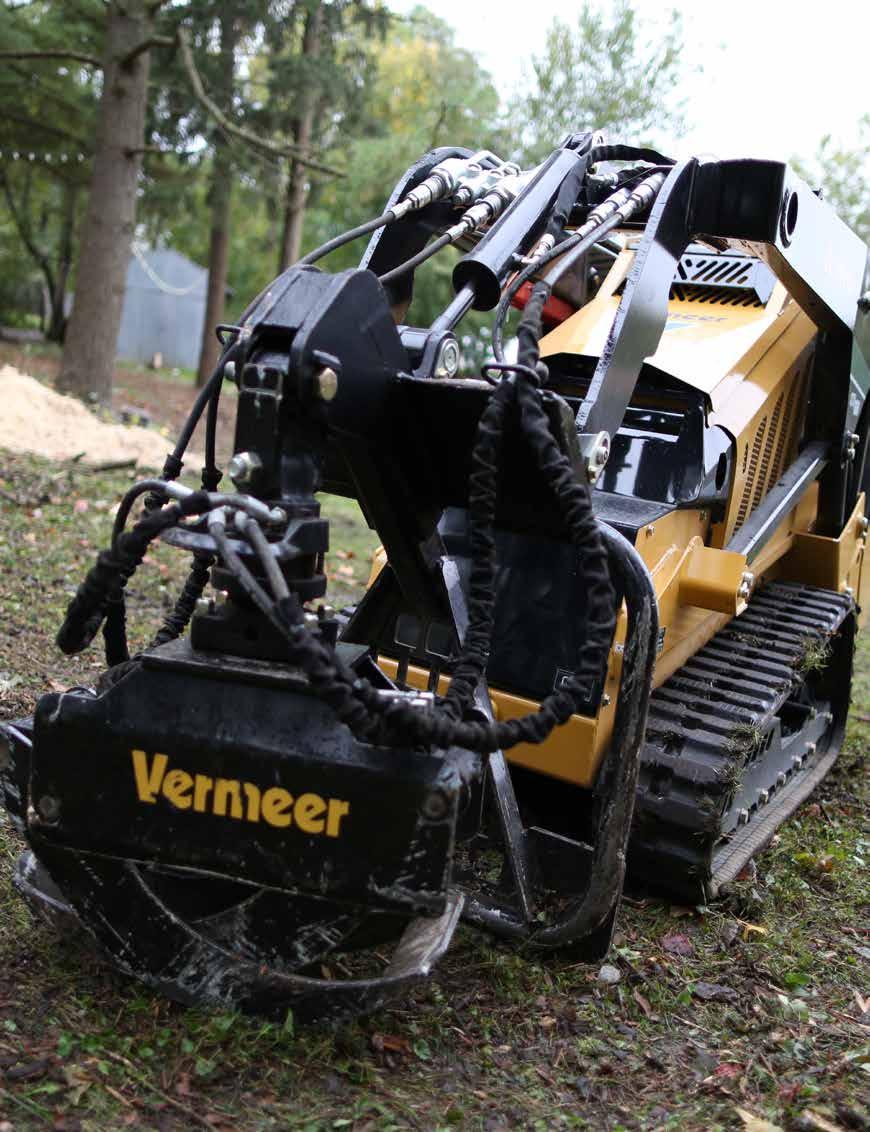
We have recently diversified in other areas, including property maintenance for real estate companies, strata companies and a preferred contractor for the Land & Housing Contract (LAHC) on the South Coast for which we have employed another two employees.
Kind regards, Glen Keedle, All Round Tree & Garden Care. AA


“The safety culture and professionalism we have formed over the years has been another enjoyable aspect of our business growth.”

Vertical lift arms and a 40-hp (30kW) turbocharged Kohler KDI diesel engine gives the CTX100 exceptional lift and tipping capacities, coupled with the operator-centric features common to all Vermeer loaders. Grasp, lift and move brush and logs with ease and efficiency thanks to Vermeer’s Mini Skid Steer Loader range and the Rotating Log Grapple attachment with 360 degree rotation. Perfect for arborists doing the ground work and all tree care companies. Contact your local RDO Vermeer team today.

VERMEERAUSTRALIA.COM.AU | 1300 VERMEER
Vermeer and the Vermeer logo are trademarks of Vermeer Manufacturing Company in the United States and /or other countries. © 2022 RDO Equipment Pty Ltd (trading as Vermeer Australia). All Rights Reserved.

On the last weekend of May, the men and women of the TCAA gathered within the convention centre of St Joseph at Seven Hills. The cups of tea and greetings were amid voice overs of old colleagues and new friends coming together for the TCAA Training Day. Togetherness is tough after not physically meeting for two years as an association.
The first speaker of the day was introduced by Bruce Smith, who hails from Orange, inviting Dan McArdle to the podium. Dan professed the use of the Pre Climb Assessment and related this to AQF 3 outcomes from the Government Training Packages. Dan’s main thrust of In-House Training, due to labour skills shortages, focused on allowing PUCB (Persons undertaking and conducting business) and team leaders to instruct on best Industry practices within their own organisations; hierarchy (transits) of control and persisting with gear checks and quality tests, bringing what you know to a toolbox meeting.
The Safe Work approach utilising SWMS and JSA documents – including ALARP
and SOFARP – were readily defined by our guest speaker. ALARP is related to trees and risk where as SOFARP is related to all WH&S documentation in business by law.
Dan also reviewed safety issues:
• VTA
• Species
• Vigour
• Defects
• Exposure
• The Hierarchy of control
• Use of EWP as first option
• Where and when climbers are used if other areas of access are restricted due to safety factors
• The use of registered gear and logged gear
• The proper care including percentage of wear
• Dated materials

• Relegating old gear to the non-climbing bench
• Access methodology for difficult sites and the need for expert advice within the TCAA or TTIA - Timber Trades Industry Association on serious threats within the workplace.
The main event from Bill Sullivan progressed with tree risk and the usage of the vTRA system. Bill discussed the ‘Voo Doo’ Science of 154 tree risk systems used on the planet
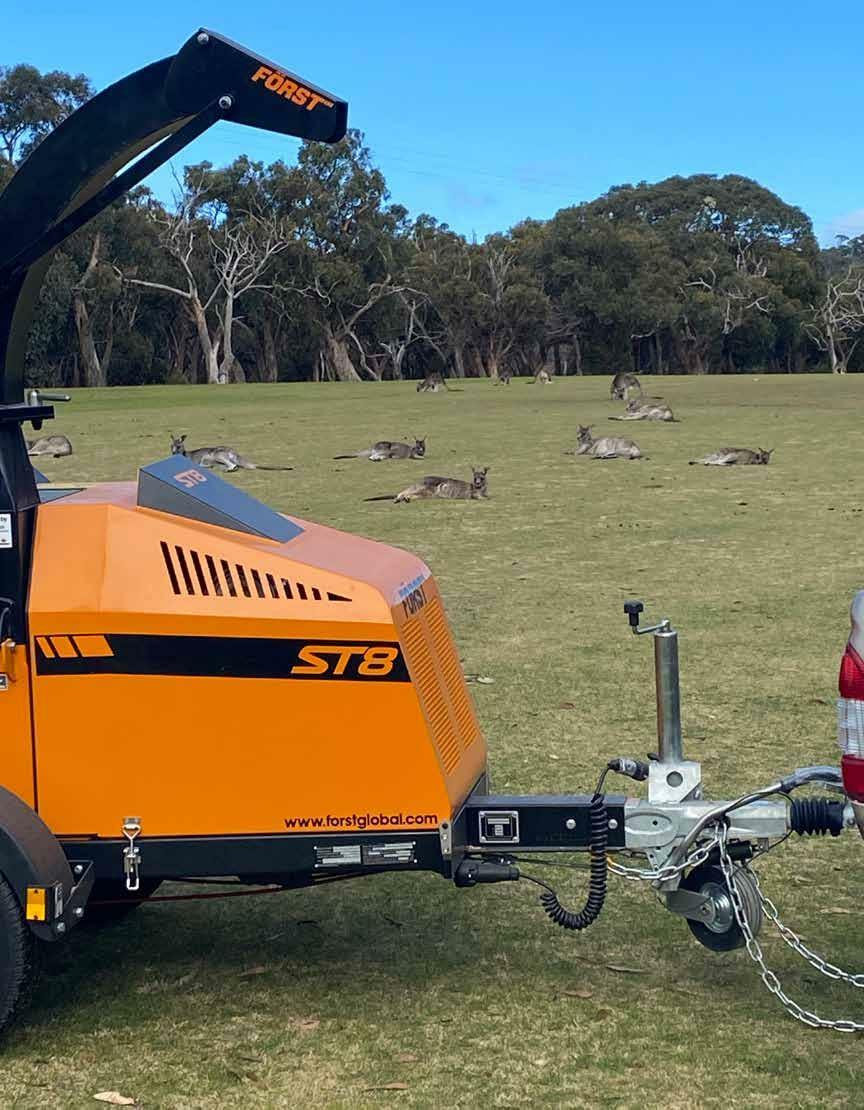
from all aspects of the tree industry. He elaborated on the chocolate wheel probability and gave clear definitions of reasonable practice including risk, target, occupation descriptors, the assumption of consequence and the role of the TCAA arborist. Bill’s view of specific management on the Top End trees, like the African Mahogany and other boat brought immigrant trees that peppered the shallow soil profiles.
Bill also discussed:
• The need for educating tree workers, who require in-servicing or inducting
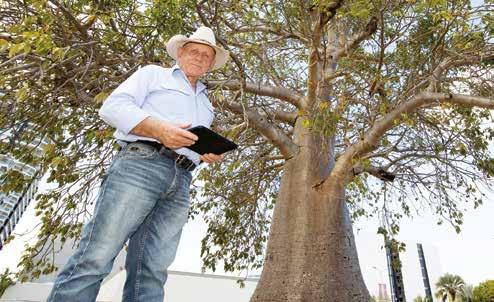
• The mentality of cutting tree roots to put down paving with cause and effect coming into play as well as windthrow of these affected trees
• The major issues of over pruning and the loss of the branches or decay of branches that fail from poor management practices.
Bill gave us an extract from Kenneth James and the issues of wind exposure on trees, a study dear to his heart. (Bill is from NT and closest city is Darwin – the Cyclone city).
Bill also alluded to the reasons plastic snakes were used as a deterrent for bats in the Botanical Gardens which can be still seen today. The tourism boost has significantly increased the gardens patronage.
Bill went on to address the Coroners’ reports regarding fatalities from falling tree branches. Bill was an expert witness for the court.
He also discussed the deaths in our society as well as the impacts on families and industry. All trees have risk and can be assessed from three levels by a competent arborist:
• Level 1: can be done by the general assistant or worker who has knowledge of the area to identify changes to a tree, or the arborist
• Level 2: can be done by the AQF 3 or AQF 5 – the VTA is a prelude to the check for issues and defects
• Level 3: can be done by the AQF 3 or AQF 5 but is when there are a variety of factors like exposure, species, variation and defects. Only a AQF level 5/6 Arborist can report on this level of inspection.


Bill has an AQF level 6 Arborist accreditation who’s motto is “know your tree before you give management advice”.
A TCAA general industry meeting followed, during which the president gave the 27th annual address “enthusiastically” keeping the association vision ‘Safety Experience Trust’. Lunch followed which was always going to be a gathering of what’s happening in the trenches over sandwiches and who’s voting in who.
Jim McArdle – Final address as President Jim McArdle gave an unveiling of the 2022 Tree Management Guidelines
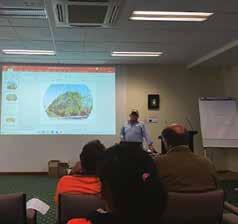
He proceeded through the key points of the industry approved methods, highlighting the serious nature of current tree work incidents from Safe Work. He discussed the history and reasons the Tree Management Guidelines were produced from its inception in the 2008 Adelaide TCAA conference with Jeremy Barrell (UK Arborist) and the evolution of the document propagated after the tree deaths incidents in schools.
Best industry practices were defined and stated as being “the exercise of that highest degree of professional skill, diligence, prudence and foresight which would reasonably and ordinarily be expected from a skilled and experienced operator or assessor engaged in offering licensed services”.
It was discussed why TCAA arborists are the safer arborist with lower worker compensation rates and higher safety standards.
The afternoon gathered momentum with benchmarking of the senior level 3 and 5 arborists venturing through five common tree examples. The level 1, 2 and 3 risk assessment which ‘fit for purpose’ and assisted in conducting assessments in a reasonable decision-making proactive tree risk approach. A number of scenarios were reviewed and best management outcomes sort. Teams were arranged to engage on benchmarking the assessments of five
indigenous large trees – with the huge availability of hollows, bees and birds, targets and valued camellias being guarded and the group of arborists delegating responsibility to either duty holders or the assessor.

Most notable questions were:
• How do we come to the same conclusions? Outcome – Do a VTA and check occupation and target
• Do I have to increase the occupation rating if a seating arrangement is placed under a (dead) tree?
• What ecological values are found in an assessment?
• What other experts are needed if a court case ensues?
The feedback was unanimous and a Training Day for workers who could not attend will be prior to the next general meeting, ensuring all members are relicensed with this training module.
In summary, the issues of Access and Preclimb, having assessing arborists who are from the industry, assessing defects and health and structure of a tree and utilising hierarchy of controls within Safe Work, including our integrated “Code of practice”, found in The Tree Workers Guide underpins the best industry practices within the TCAA.
The industry women who attended, the AQF 3 and 5 arborists and those preparing for AQF 5 and guests, enjoyed the location and training.
For further information on the Tree Management Guidelines please contact admin@TCAA.com.au or call Jim McArdle on 0449 228 788.
The new executive was voted in:
• President - Carson Smith (Ned Kelly)

• Vice President - Jim McArdle
• Treasurer - Murray Boland
• Secretary - Bruce Smith
• Committee - Jeff Hunt, Brady Blaker, Dan McArdle
• Compliance - Dan McArdle
• Media representative - Robert McArdle
It is noted that the past three presidents were regional and the new metropolitan man who has won the presidency will take a new CRUNCH approach (with careful responsive understanding certifying harmony) with a vision for ‘All the Way with the TCAA’ to increase in training and safer work practices.
For Tree Contractors Association Australia membership enquiries, please go to www.tcaa.com.au/ membership/ or call 1300 660 379 or email admin@tcaa.com.au AA

Glenn and his team put thousands of hours into their old Bandit 150XP chipper, and they’ve just upgraded to another Bandit.

If you were looking for the toughest chippers in Queensland, it would be hard to beat Professional Tree Works’ Bandit 150XP, a machine that was the bedrock of the business for over 12 years.
Professional Tree Works is based on the Gold Coast, and director Glenn Dalton was rapt with the reliability of his old Bandit, before upgrading to the new Bandit 15XPC.
“We had it [the 150XP] for at least 12 years. They just last and last and last. We’re really happy with everything at Bandit,” says Glenn.
“Jason and the Bandit team’s customer service is outstanding. He always stays in contact with you direct, asking if you need anything and not to mention he cares about his customers for the long term after each sale.”
After upgrading to the 15XPC in 2021, Glenn and his team have already racked up 300 hours on the new unit and have been impressed with the Bandit woodchipper’s gutsy performance.
“We’re really happy with the 15XPC as well. It’s a fuel saver. And with the logs, it just
specialising in tree pruning, tree removal, stump removal and palm removal.
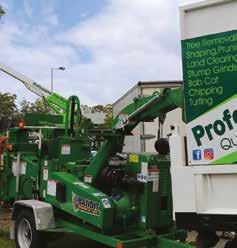
Glenn has a passion for all his clients making sure after each job is completed to a standard like no other. The business was awarded ‘Best Full-Time Arboriculture Business - Tree Trimming Gold Coast’ at the recent 2021 AI Global Media Corporate Vision Small Business Awards.
“We keep everything local. We’re lucky that we can do the five to ten-kilometre radius,” says Glenn.
chews straight through, there’s no problem that’s for sure,” says Glenn.
“I like that the chipper is compact, while still being extremely efficient. This size allows the chipper to be used on tight jobsites where other chippers may not fit.”
One of the great qualities of the 15XPC is its large engine, delivering the same power as its big brother, the Bandit 18XPC, in a smaller machine.
“The standout features are the chipper weight of 3,400kg, allowing to us keep our MR truck rather than investing in a larger truck,” says Glenn.
“Also, the Cat engine with a huge 624Nm of torque, and the infeed throat opening 495 x 381mm allows you to feed larger logs lying flat up to 17 inches.”
Other impressive specs of the Bandit 15XPC include:
• A CAT 142-horsepower diesel engine
• Easy manoeuvrability in a compact size
• 19" wide x 15" high drum style chipper
Glenn has been in the tree removal business for 30 years. Professional Tree Works primary customer base is located on the Gold Coast,

“We can do the tight access with our four stump grinders and handle the larger jobs as well. We always have a minimum of three staff on site, and keep up to date with ongoing training,”
“I got into tree game with my brother-in-law years ago. The first week that I was in it, I was pretty much lowering ropes all around me. I didn’t like it one bit. And then eventually, I stuck with it and I’ve been doing ever since then. It’s great and I enjoy it.”
For more info visit www.banditchippers.com.au and https://protreeworks.com.au AA
“Jason and the Bandit team’s customer service is outstanding. He always stays in contact with you direct, asking if you need anything and not to mention he cares about his customers for the long term after each sale.”
Chris Capsis, owner and lead Arborist of Outdoor Tree Service, is a multi-facetted guy, a marine mechanic by trade, surfer and arborist, who realised nearly a decade ago the increased speed, efficiency and safety of working from spider lifts and EWPs. With the 11-meter outreach of his CMC S18F, Chris and his team are safely and efficiently completing jobs in times that simply weren’t possible when only climbing.
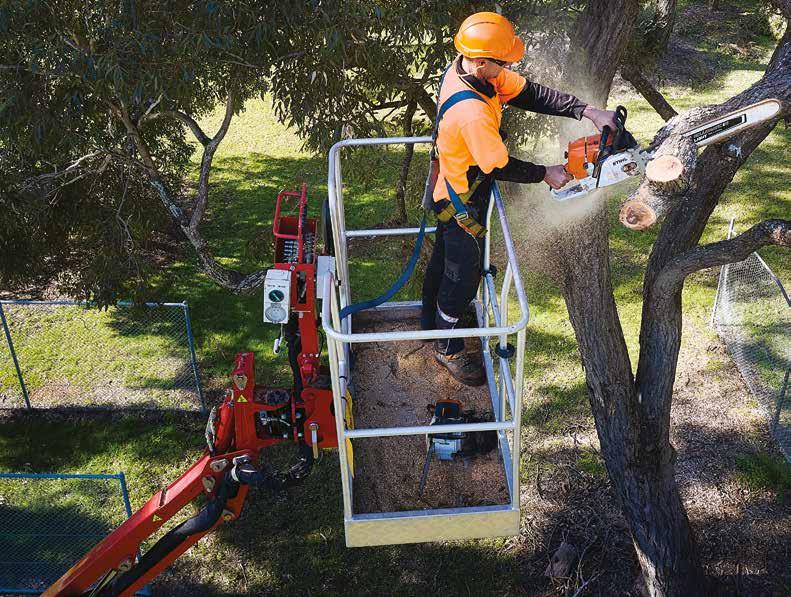
ith 22 years as an arborist under his belt Chris has seen many changes in the industry over his time, some he is a fan of and others not so much. But one thing for sure, Chris and the Outdoor Tree Service team have fully embraced and love their CMC S18F.

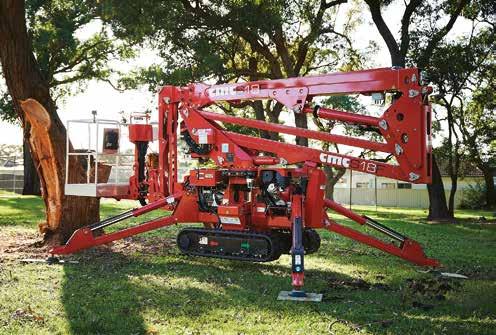

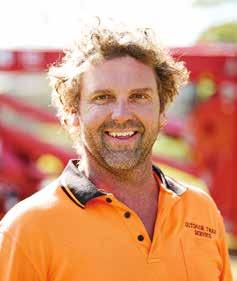
Chris shared: “I started out with a lawn mowing business and I used to live with a mate that was in the tree business. After starting to do work with him and finding I was well suited to the industry and had a passion for it, it just evolved from there. Having a mechanical background allows me to do a lot of maintenance and repair work myself saving the company thousands in repair bills and reducing down time costs.”
A small but highly efficient team
Chris has gone through several incarnations of his business over the years with it at one stage involving three crews, and all the headaches that go with running a larger team. Today Chris has gone full circle deciding to run with a smaller and more efficient team. “I have given up on trying to please everyone all the time, instead today I focus on keeping our smaller team happy and productive, we run two 4x4 chipper trucks, 1590XP and 915XP Bandit chippers, Bandit and Rayco stump grinders, a 40ft truck mounted EWP, track CMC spider lift EWP and Stihl chainsaws. My first machine was a Bandit 9-inch chipper about 20 years ago. They have evolved a lot since then. My first stump grinder was a Rayco 1625 super junior stump grinder. Other equipment we have purchased includes an RG 50 4x4 super, an Angry Ant loader and recently the CMC spider lift.”
The CMC S18F excels in real world conditions
Chatting with Chris about the challenges of climbing, shoulder injuries and surgeries it highlights the massive advantages that the CMC S18F has bought to Chris’s business and how that directly translates to the significantly faster completion of jobs, added safety and reduction in work-related injuries onsite. “The ability of the CMC S18F to work in real world conditions is one of its best features – from the adjustable tracks which can reduce to narrow width of access of 770mm allowing it access into doorways and narrow gates, to its massive horizontal reach of 11m and 18m of height.
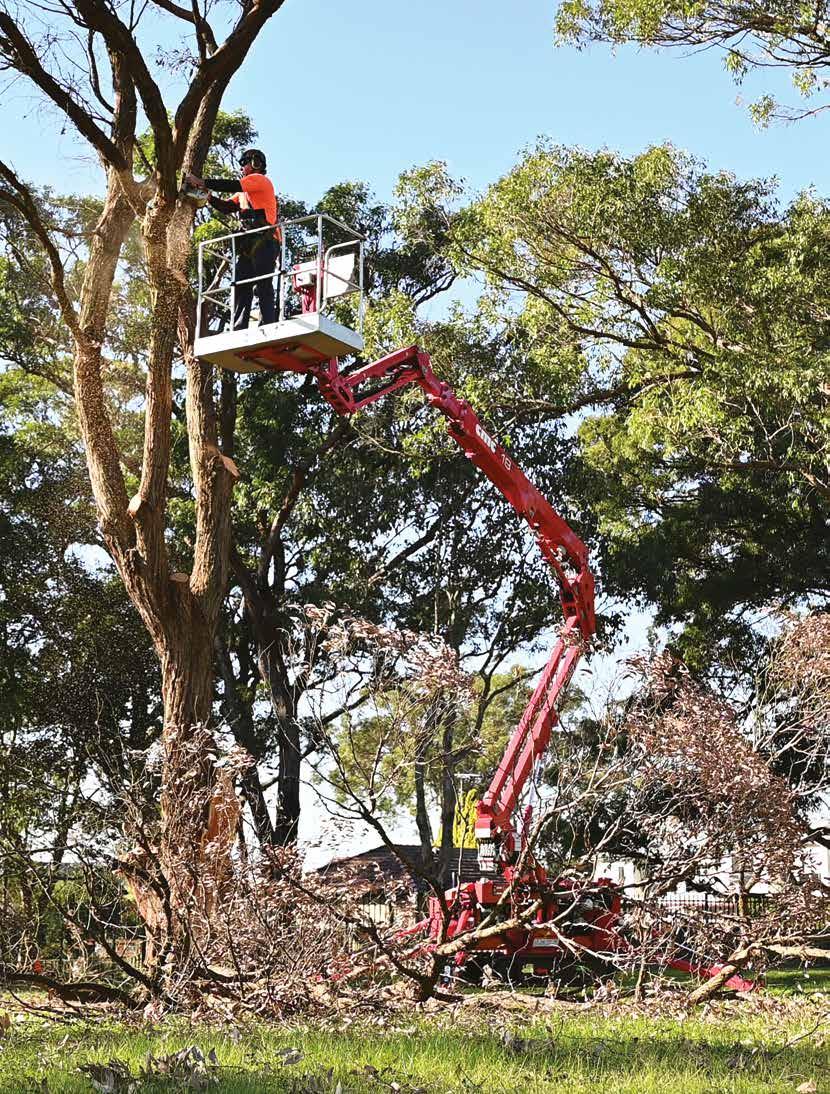
The basket can take two people and it’s an all-round reliable and stable machine and has been a great addition to the business. I’m proud that my hard work in the industry has paid off and I have been able to own my house and my machinery,” shared Chris.

The success of the CMC S18F comes down to a clever and reliable design. Chris has owned other similar equipment previously which just didn’t stand up to the type of work he and his team undertake. The S18F comes equipped with a single pantograph and two stage telescopic boom plus jib, mechanically adjustable tracks in height and width, with an impressive lateral outreach. This is a truly multipurpose aerial platform with amazing performance which is suited to both commercial use and rental companies.
Stuart Samson from Global Machinery Sales Chris has been purchasing equipment from Stuart Samson from Global Machinery Sales for more than eight years and the two have built a great relationship over that time. With both Chris and Stuart having a wealth of individual experience and industry knowledge, the two have worked together well on ensuring Chris has the best information and equipment on hand. “Stuart Samson has been a great asset as he has worked and knows the industry, he’s very easy to talk to and deal with. After sale
service and advice is paramount and Stuart has always provided this to a high level,” said Chris.
Stuart Samson himself has been the NSW State Manager at Global Machinery Sales for eight years now and has been working with Chris for that entire time. When asking Stuart about the relationship with Chris and the purchase of the CMC S18F, he shared: “It’s been a great opportunity to work with Chris and watch the business evolve to where it is today. Chris is a great example of clever business owner who embrace the philosophy of working smarter not harder. The S18F has been a great addition to the business to enable exactly that – with Chris now not taking on jobs, where he can’t use the S18F. It allows them to perform their job in a safe and efficient manner with its stability, narrow access and class leading outreach of 11 meters. Chris Capsis has been a great customer
over the years, with our relationship starting with Rayco stump grinders and now with CMC Aerial Platforms. The S18F has been such a good fit for Chris and so many other businesses. It’s no wonder CMC with their attention to detail, excellent service and innovative design have grown to the world’s largest tracked EWP manufacturer.”
CMC S18F
• Max work height: 17.78m
• Max reach (with 80kg): 11.15m
• Platform height: 15.78m
• Max load in basket: 230kg
• Min. track width: 0.77m
• Basket rotation: +/- 90 degree
For more information visit outdoortreeservice.com.au and globalmachinerysales.com.au AA


“The ability of the CMC S18F to work in real world conditions is one of its best features.”
Manufactured for the Australian market, the Snorkel line of trailer-mounted boom lifts features a range of capacities and lifting heights along with an array of features.
The portability of a trailer mount makes the Snorkel machines ideal for contractors who work at multiple jobsites.
The Snorkel MHP15HD is a heavyduty trailer-mounted boom lift that offers durable performance and precision on the jobsite. Rugged and reliable, the MHP15HD is ideal for general maintenance and construction. Automatic self-leveling capabilities enable safe and versatile work at height.
The MHP15HD’s durable two-man steel platform can lift a safe load of up to 200kg up to a working height of 14.8m. Additionally, a 600V AC rated wire platform allows operators to use power tools up high. The MHP15HD is also equipped with fully proportional speed controls for added flexibility. A versatile jib with 140° rotation delivers smooth and accurate precision, while enhanced side-to-side maneuverability provides better access to hard-to-reach places. Fitted with a superb 5hp engine, this trailer boom provides reliable performance, while optional bi-energy power offers clean and quiet operation in low-emission environments.
The Snorkel MHP13AT is a robust and reliable trailer-mounted boom lift that is ideal for tradespeople and facilities maintenance applications. With a working height of 12.9m and a platform capacity of 215kg, this model features the lowest total weight of the MHP line of trailer-mounted boom lifts at 1,360kg.
The articulating boom sections provide upand-over reach, making this model ideal for awkward working angles.
The Snorkel MHP13/35 features a maximum working height of 12.9m and the largest platform capacity in this line of trailer-mounted boom lifts at 227kg. The versatile jib boom and maximum reach of 5.6m make it ideal for a wide range of tree care, landscaping,

construction and maintenance applications.

All three of the MHP trailer-mounted boom lift models feature a rotating basket mount, automatic self-levelling hydraulic stabilizers, and a heavy-duty tow coupling.
For more information call the Ahern Australia team on 1300 900 700 or visit ahernaustralia.com.au
Waimea Australia, a division of Monitor Lifts, launched a 29m Truck Mounted EWP on an 11 ton GVM chassis.
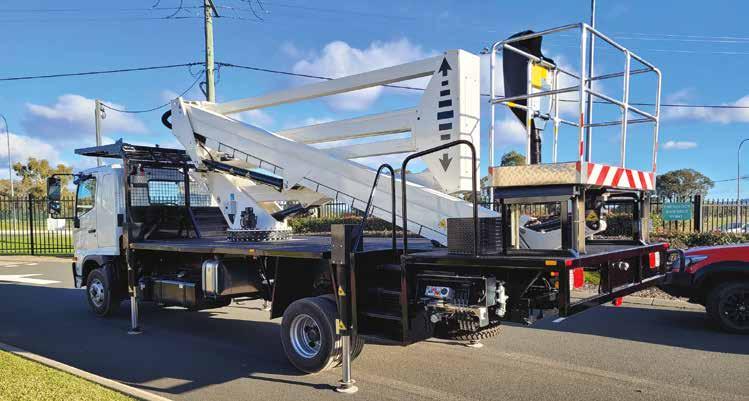
This new Waimea unit is amazingly compact, with vertical outriggers and a large 250kg SWL with unrestricted outreach to 15.6m.
Truck mounted EWPs can be advantageous when doing multi-location, same day set-ups or projects requiring long distance travel. Especially being a registered road going vehicle, this can prevent any hassle with traffic management or permits. A unit such as the Waimea E290PX packs a real punch, with all the benefits of a medium size truck, with economical running costs.
Setting up is very fast; simply pull up, engage the PTO, climb out of the vehicle and level the chassis by lowering the stabiliser legs and you’re right to elevate.
The clever double-knuckle boom design of
the Waimea E290PX provides an excellent working area, from ground level right through to working height, with very minimal tail swing. The 2-man, 250kg SWL is available
throughout the entire envelope providing unrestricted outreach.
The four x vertical heavy duty stabiliser legs allow the truck to set up on all sorts of terrain and provide a very nice sturdy base to ensure excellent stability at height. The stabiliser legs do not protrude past the edge of the truck tray, allowing setup in very confined areas and within one lane width if doing street work.
Smooth proportional hydraulic controls allow very precise operation, and also provides for fast boom movements when required. Multiple functions can be made simultaneously. Platform rotation is standard and can assist when manoeuvring into tight areas.
Waimea Australia can even provide radio control options, automatic stabilisation / levelling, custom tool box design, roof and cab protection, etc. Step aboard and be ready to hit the road for the next project!
The Waimea Truck Mounted EWP designs are very compact, allowing for tight access and efficient operation. There are telescopic and knuckle models from 12m – 36m available to suit any requirement.
For more information on the Waimea Australia range, please call the friendly team today on (02) 8610 5601 or email trucks@waimea.net.au. Whether it’s sales or hire, or Hire 2 Own, Waimea Australia is sure to have an option to suit your needs.
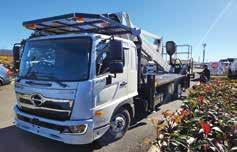
The Monitor 2095 Spider Lift is becoming increasingly popular in the Arbor industry thanks to this machine’s incredible features and benefits.
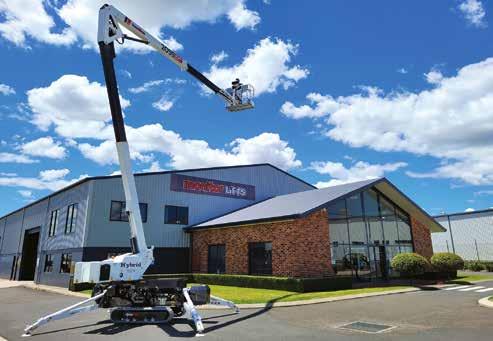
With a big 250kg basket capacity, the Monitor 2095 has an incredible unrestricted horizontal outreach of 9.5m. Therefore, meaning that two men and saws can still achieve maximum outreach.
With a unique double-telescoping boom design, this provides the operator with superb up and over-reach which as you know is very important, especially when in your tight access, backyard applications.
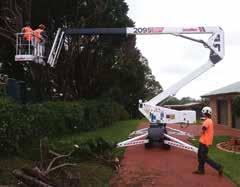
All hydraulic hoses are routed inside the boom, removing the possibility of them being damaged by branches or other obstacles.
The Monitor 2095’s radio control provides smooth proportional functions and allows the operator to manoeuvre the machine comfortably into position, allowing them to move freely around each side of the machine.
Running a quality twin cylinder, air cooled,
Kubota Diesel Engine, the Monitor 2095 has the option of a 240-volt electric motor or onboard Lithium batteries therefore converting the machine into a Hybrid. This therefore provides you with the option to work quietly,
emissions free and efficiently if you’re wanting to make an early start. Now with the modern age battery chainsaws, you can get the job done without your customer even knowing you are there creating an excellent customer experience.
The Monitor 2095 spider lift features a fly-jib and basket rotation allowing you to have much greater manoeuvrability in the tree canopy. These two features are critical in helping you achieve complete your application to a high-quality standard.
Non-marking rubber tracks are an option for use on sensitive floors, and air and water lines are routed up to the basket to allow the use of pneumatic tools or a pressure washer. This therefore allows you to offer your services in not just Arbor work but also property maintenance such as roof and gutter cleaning.
The radio control is also used to operate the stabiliser legs which have the excellent ability to automatically level the spider up on uneven, slopping applications. Stowing to only 790mm wide thanks to an easily removable basket, 5140mmlong and 1990mm high, the Monitor 2095 has the amazing ability to navigate through a single doorway making this machine ideal for tight access applications.
Built to tackle rough terrain, the Monitor 2095’s tracks expand out and down to provide greater stability and excellent ground clearance. Two speed drive also allows the operator to move the machine very quickly from job to job.
Weighing in at only 2910kg, the Monitor 2095 can be towed behind most tradesmen’s vehicles on either a 3.5T Alloy Trailer or 4T Galvanised Steel Trailer which are both made in Australia.
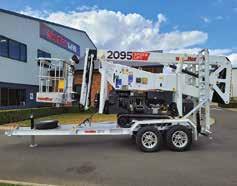
CMC Spider Lifts are taking Australia and the rest of the world by storm, growing to be the largest Spider Lift manufacturer in the world.
CMC Lifts offer a range of compact and highly manoeuvrable spider lifts as well heavy-duty spider lifts with big height and reach. The CMC spider lifts that Global Machinery Sales stock for the Australian market range from 13 metres in height through to 41 metres.
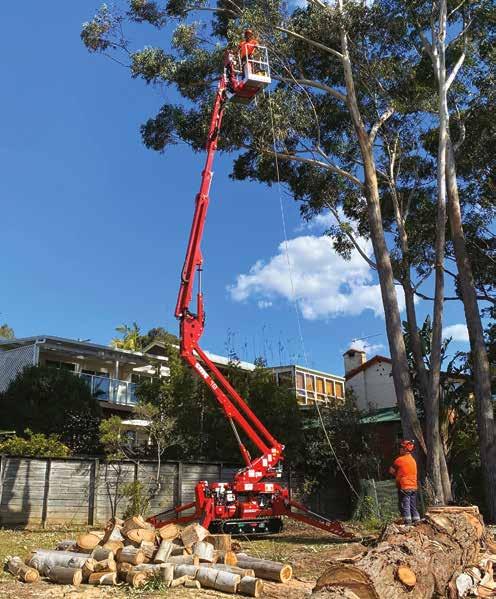

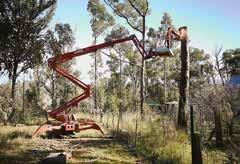

Each lift has an impressive outreach, powerful engine and large basket capacity.
The CMC S18F and S23 Spider Lifts are quickly becoming Australia’s favourite lift, selling to a range of businesses all around Australia.
The CMC S18F is a fully hydraulic and easy to operate lift that offers customers 17.78m of height and an impressive 11.15m of outreach at 80kg (8.7m at 230kg).
The S18F is lightweight and compact, meaning it is a great machine for those tight jobs where access can be limited.
The S23 model is an excellent combination of weight, strength and working height, it is a compact lift with the longest outreach in its category. The S23 model has a maximum working height of 23m and an unrestricted outreach of 12.4m, making it an extremely attractive lift for businesses that are needing outreach for difficult access jobs.
CMC Lifts are certain that they have a spider lift that will suit your business’ needs.
For more information or a demo on a particular model, please call Global Machinery Sales on 1300 072 926 or visit www.globalmachinerysales.com.au
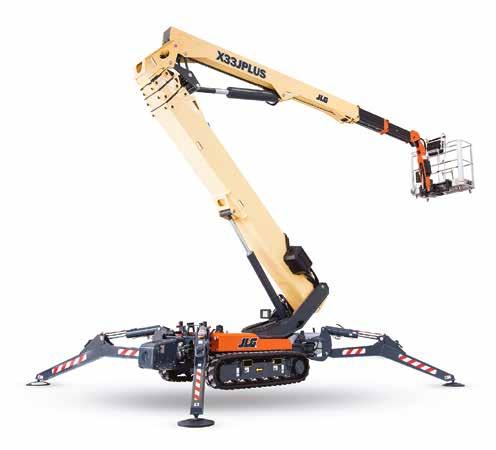
The release brings JLG’s CCB line-up to five and provides an entry into the 30m height class.
Along with bolstering the choice for JLG’s CCB customers, the new X33J Plus offers a market-leading work envelope including 17.20m up-and-over height and 16.5m of horizontal working outreach.
The machine also provides below-grade capabilities, making it suitable for both above and below level work.
A further benefit of the X33J Plus is its class-leading 230kg unrestricted platform capacity, allowing operators to bring additional materials to the work area, leading to a more productive work environment.
While the JLG® X33J Plus CCB is big on features, its compact footprint also makes it extremely versatile and functional.
At less than 5.80m long and under 1.20m wide when the platform is removed, the new model is highly manoeuvrable and will even fit through double doorways, for hassle free movement between outdoor and indoor work zones.
Disconnecting the platform is efficient via a patented system, while retractable, non-marking tracks reduces the likelihood of damage when the X33J Plus is working on sensitive surfaces.
Powering the X33J Plus is the Bi-energy package. Using a switch mounted on the control panel, the operator can select from two power sources – diesel or electric –depending on their preference or application requirements. The diesel option uses a modern T4F (Stage 5) Kubota D902 engine which produces 16.1kW (21.6cHP), while electric power comes courtesy of a 100Ah / 83V Lithium-ion electric engine.
JLG Industries Product & Marketing Manager – ANZ, Arron Cooper, said the latest addition to the JLG line-up further
strengthened the company’s product offering, allowing the company to cover even more markets.
“The revolutionary X33J Plus demonstrates JLG’s continued commitment to delivering a wider range of high-quality access equipment possible to the industry,” Arron said.
“This recent addition to our CCB range allows operators to reach the greater heights they require, while giving them the increased machine flexibility to comfortably navigate around jobsites.”
“We believe the X33J Plus will be well received by operators who regularly
work on jobs with tough, hard-to-reach indoor and outdoor access requirements, including atriums, gymnasiums, arenas, auditoriums, airports, schools and universities, as well as local council, state, federal and military facilities.”
“The X33J Plus’ versatility and ease of mobility also makes it ideal for hotels and convention centre settings and for use by window washers, painters, maintenance professionals, electricians tree trimmers and others.”
To learn more about JLG, visit the company website at www.jlg.com.au
JLG Industries’ boom lift line-up has grown once more, with the recent launch of the X33J Plus Compact Crawler Boom (CCB).
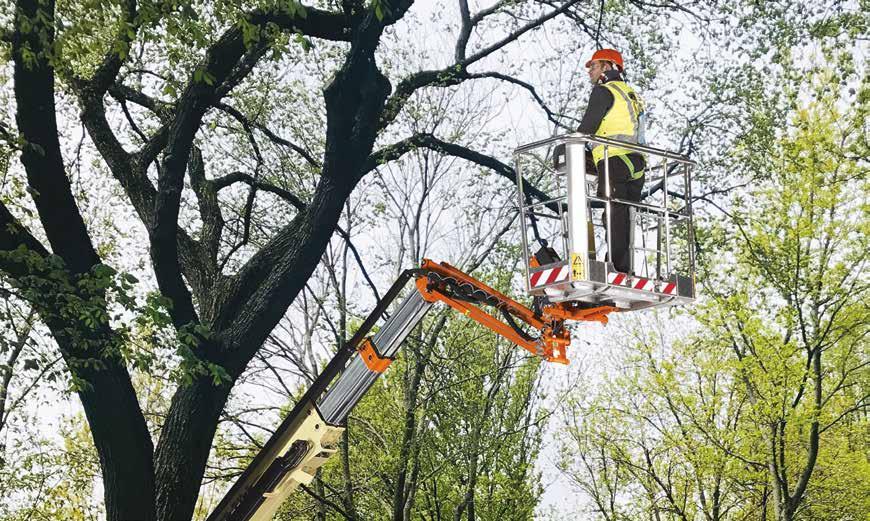





Looking at spider lifts, the accessibility offered makes them an unbeatable choice, so which specifications should you be looking at?
• Good return on Investment = High Utilisation
• High Utilisation = Design + Performance + Transport + Reliability.
As you know we can be three times more productive and safer if we work out of any EWP, not to mention avoiding being fatigued halfway through the day.
Reducing labour costs is the first and foremost element that should be looked at when surveying the bigger picture of any industry, as this is the biggest cost to business that can be reduced.
One of the keys to reducing time in the air is with smarter designed ZED style boom configurations.
The True Zed style boom system is by far the most versatile and productive of all, creating a larger working envelope without outreach weight limiting, offering faster
deployment and positioning times. This, combined with providing a more natural, versatile approach to operator boom movements (as old-style arching movement designs will take up to three times longer to position), plays a massive factor in rapid positioning works such as arboriculture.
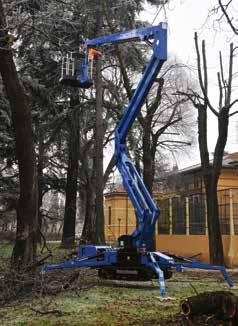
Today it is all about reducing labour cost, and that means a call for increased productivity – which comes from the superior design style offered by the Z Boom System.
As every site is different, access and set-up once in the site are always the challenges presented. This is what a Spider Lift is supposedly all about, but many of the older designs fail here.
If we cannot access the site, we lose utilisation.
• Dimensional length
• Width
• Gradeability
• Departure angles
A machine that has smaller dimensions and higher gradeability can give us the maximum ability to access the job along with assisting in setting up in tighter work areas to then conduct the job.
There are many other factors to consider once on site for set up, especially smaller stabilisation footprints, zero tail swing and up and over capabilities to deal with avoiding obstacles and obstructions. All these aspects of design and performance specification aid in increasing a machine’s utilisation factor.
Spider Lifts provide an excellent solution for a transportable all-round EWP, especially for businesses involved in working at heights.


Transportation costs are extremely important, especially when doing multiple jobs per day.
Many people miss the importance of this area, and how it relates to weights and dimensions, trailer designs, braking, load limitations and tow vehicles GVM’s. Improvisation will affect time management, all of which play additional factors in the all-
The Arbor Industry has been seeing the benefits of employing Elevated Work Platforms to increase safety and decrease labour times while working.
But what makes an EWP a good investment for your business?
up and ongoing costs.
Note: Currently passing through government national roads rules is a limit that will be placed on the 50mm towing hitches for up to 3.5 tonne vehicles and will be limited at 2900kg tow capacity.
This now means more importance needs to be given when assessing tow vehicles for a more cost-effective transport solutions, especially for machines in the 17/20m mark.
The idea is to look at the machine make-up for better reliability and keep it simple.
Spider Lifts are a unique style of EWP compared to all other machines, in that they are extremely compact machines with a lot going on in a small area.
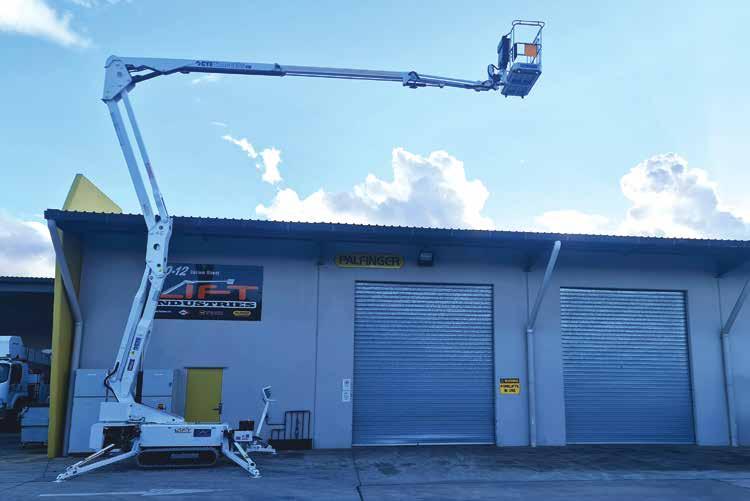
Today’s safety standards for EWP’s requires many electronic safety controls to protect the operator, but also with more electronic features such as self-levelling.
Many are running weight limiting outreach systems that limits the telescopic extension by basket weights based on 80/120/200kg

weights. These are and quite often complicated systems of load management protecting the stabilisation, which do not benefit the user in the bigger picture.
Varied stabilisation with masses of limit switches both on stabilisers and booms also create technical diagnosis nightmares.
These can be, and are in a lot of cases, costly to maintain.
A standard fixed envelope system is by far more reliable and less complicated, and machines with less features such as auto levelling, and outreach limiting etc. are smarter from a reliability point of view. Booms that house the hydraulic and electrical service are preferred for less hook ups and deterioration. All these factors make for a cost-effective approach to reliable service over the term of ownership.
When assessing Spider Lifts, CTE’s Traccess Range stands tall above the competition. They offer all of the vital features discussed above, and more.
Overall, there are many considerations a business owner or manager has to make, no matter the scale of the operation. When looking at maximising your investment, the factors discussed here are vital. To help you make the expert decision, it is vital to understand the different elements that will improve profitability.
For more info visit www.platformsales.com.au or call 1300 882 762 or 0428 986 116. AA
Active Green Services has worked with LGAs around Australia to develop a world-first management tool to address large scale urban greening, providing unprecedented insight into canopy cover, critical to urban greening strategy, planning, execution and verification.
Active Green Services uses 0.5m resolution satellite imagery taken at a specified time each year and interpreted with AI (artificial intelligence – a trained, convolutional neutral network) to identify trees from visual and NIR spectral data. This is audited and re-interpreted by Certificate V qualified arborists and GIS specialists to render a tool which not only provides % canopy cover for the LGA, year on year, but does this dynamically, measuring and segregating the % canopy cover based on and any viewable, subset area.
For VMOs and TMOs, removed and
hazard (dead) trees, tree growth and pruning/ decline are clearly visualized. Information can be compared to climatic data (abiotic) and human effort, pest and disease (biotic).
For Environment, Sustainability and Urban Heat managers, this tool provides the basis for correlation and demonstration of heat island amelioration and green corridors.
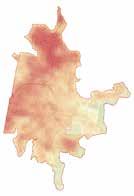
For Planners, it provides and facilitates analysis of varying spatial areas and dimensions such as Local Government Area boundaries, land management boundaries, catchment management boundaries, private property and open space.

Annual data capture and comparison to prior year is critical. Previously unaffordable through other methods, this fit-for-purpose approach lays the foundation for clearly articulated urban greening strategy which can now be described and verified in broad categories such as tree planting, tree nurturing (water and nutrient supply) and
retention (removal minimisation).
This tool has been described as a game changer. It changes the conversation from urban greening and tree canopy strategy having a “tree planting” bias (because this has been the simplest measurable) to strategies encompassing a wholistic view which, for the first time, can be measured, demonstrated and verified. It delivers hard data, practical and transparent accountability, for stakeholder management.
Canopy cover information is delivered to clients in three ways:

1. As a pdf report
2. As a weblink-based tool (ArcGIS) providing dynamic interaction and visualization, layering, etc., and
3. As shape files, suitable for incorporation into Councils’ own GIS database and system for internal strategy development and reporting, and external, web-based sharing with the public (if desired)
Mosman Council (NSW) have graciously allowed Active Green Services to share the work done for them. Various images are shown here but a copy of their full report is available as is a demonstration of the live link via Zoom.
Contact Simon Strauss on 0417 441 649 or simonst@active.com.au
With more than 30 years of developing and manufacturing equipment racks, Florida based Greentouch industries (Trailerracks) are the original and most popular tree care tool racks in the USA.
After much research and development Greentouch have recently expanded their ever-popular range with three exciting new products, all are in stock and available for immediate delivery in Australia.
The featherlight arm leverages your trimmer to ease joint pain and evenly distributes trimmer weight. It is constructed of lightweight aluminium and is easily rotated to switch between trimming and edging.
The head is adjustable and rotates to suit left and right-handed users and the whole unit is detachable within a second for easy storage and quick use.
The new backpack sprayer cage is quickly becoming hugely popular in the USA with many operators using expensive battery powered sprayers. The sprayer cage is adjustable to suit most backpack

sprayers and locks your expensive tool with Greentouch’s proven spring-loaded locking mechanism. It fits open and enclosed trailers and vehicles, is constructed of heavy-duty steel and has a wand holder for easy storage.
Another popular addition to the Greentouch range is the Multi cage. As the name suggests, this product stores and locks multiple tool types. It secures a handheld blower, a handheld hedge trimmer or a chainsaw. It has the same patented designed locking mechanism as the other Greentouch racks, it is fast and easy to use, easy to install and as with all Greentouch products it comes with all mounting hardware.
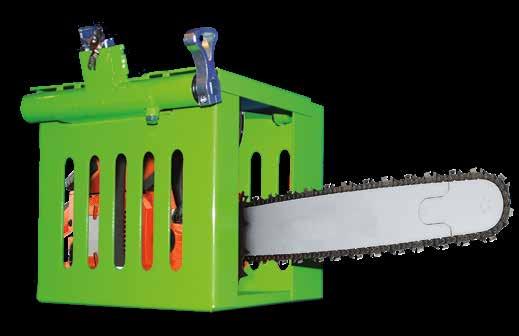
Imported and distributed by A.R.T. Landscape Tools. For more information visit www.artlandscapetools.com.au, email andrew@artlandscapetools.com.au or call 0477 772 050. AA
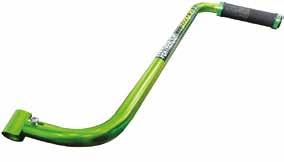
Foamstream is the leading herbicide-free solution for controlling unwanted vegetation including weeds, moss and algae.
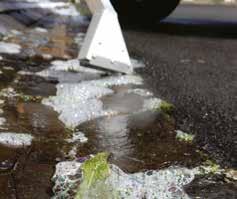
The active ingredient in the process is the heat in the hot water. The foam simply acts as an insulating blanket over the top of the hot water, ensuring heat is not lost to the atmosphere.
Using their industry-leading machinery, Foamstream is applied to vegetation at low pressure and can be used in all weathers. Once it hits the vegetation and covers it, the foam creates a thermal blanket over the vegetation and the water.
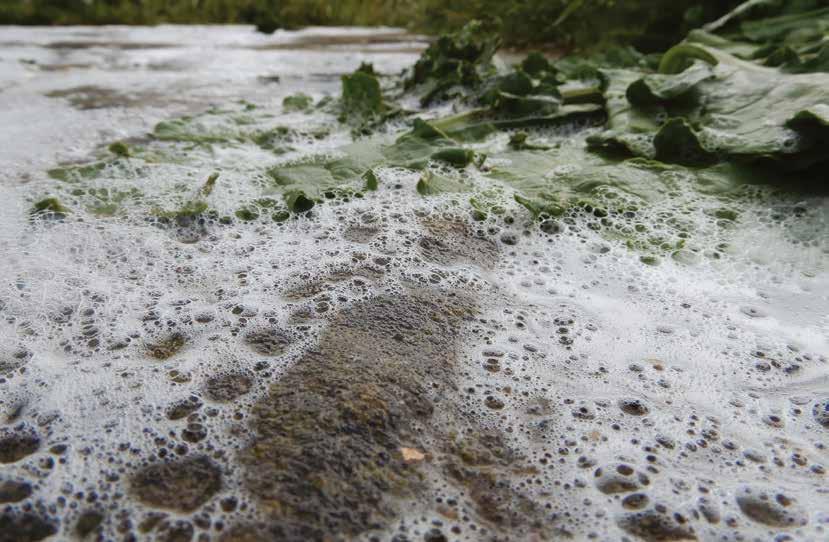
Just like the roof on your house, the foam stops the heat from the hot water escaping to the atmosphere, trapping it and holding it directly on the plant for an extended period of time.
The heat penetrates the leaf’s waxy outer layer, travels down the stem, and into the roots – killing or severely damaging the plant, causing it to die.
The longer a plant is kept in the kill zone (temperatures above 57˚C) the more effective the heat will be at killing the plant.
Its patented low-pressure process combines hot water and biodegradable foam, made from natural plant oils and sugars, making it safe for use around people, animals and delicate environments.
With the lance sets, it can also be used for chewing gum removal, pressure washing and general sanitation jobs too, making it a highly effective, all-round, green space and urban management system.
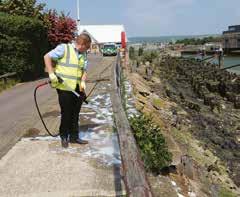
Committed to ensuring that they deliver the
safest, most environmentally friendly products, Weeding Tech can guarantee to their customers that their foams have been cleared for use as an organic, non-toxic, safe product by the four bodies listed above and also:
• Australian Pesticides and Veterinary
• Medicines Authority
• US EPA
• Health Canada
• REACH UK
• Biogrow NZ
By providing a layer of insulation on top of the water, Foamstream allows the heat in the hot water to be held within the kill zone for longer than any other alternative thermal method.
Foamstream provides the most effective way of killing vegetation, meaning fewer treatment cycles are needed per year compared to any other alternative thermal
method of weed control. By needing fewer treatment cycles, less labour is needed over the course of the year, reducing overhead costs for customers.
In addition to killing the plant, Foamstream also sterilises surrounding seeds and spores that haven’t yet germinated, helping reduce future weed growth.
By combining the most effective method, the fewest treatment cycles per year and the ability to sterilise seeds and spore, Foamstream offers customers the lowest cost of ownership and operation cost in the alternative herbicide-free space. As Foamstream can also be used for so much more than just weed control, the commercial case for using Foamstream over alternatives comes highly attractive.
Foamstream is ideal for any company, contractor, council or organisation looking to reduce the use of herbicide from their practices and replace it with the most
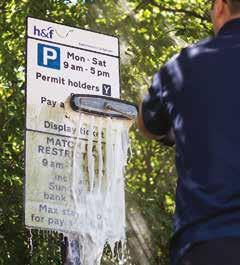
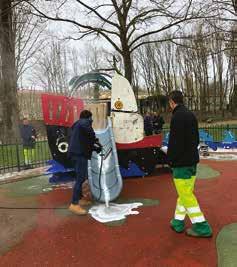


effective and efficient alternative. It is also for any organisation that needs to carry out a wide range of jobs to manage green and urban spaces, including management of artificial surfaces.
It can be used safely in public spaces, on utility sites, or in any space which requires an eco-friendly method of treatment, and poses no threat to people, animals, the environment or the operator.
For more information visit weedingtechaustralia.com au or call 0449 945 453.

Teufelberger Treecare has been present for many years on the Australian market and offers nearly 450 products to arborists through its network of dealers. But Teufelberger undertaken a global overhaul of its distribution system and its partnerships in order to be able to offer the best products and services to all arborists on the Australian continent.
The Austrian company signed an exclusive import and distribution agreement earlier this year with Sydney-based RISE® Equipment, who was founded by Clancy Simpson. RISE® Equipment has developed a nationwide dealer network and will be taking part in multiple events in-country and maintaining Teufelberger stock locally in Australia to service the demands of the market for arborist products.
RISE® Equipment (rise-au.com) is a
professional equipment supplier for the heights industry. It has been specifically tailored to a range of at height professions including arborists, rope access technicians and riggers (entertainment riggers –industrial riggers – stunt riggers).
Teufelberger has also decided to expand its ambassador program to Australia with the addition of Chris Maata, an Australian arborist living in the Sydney area, who will
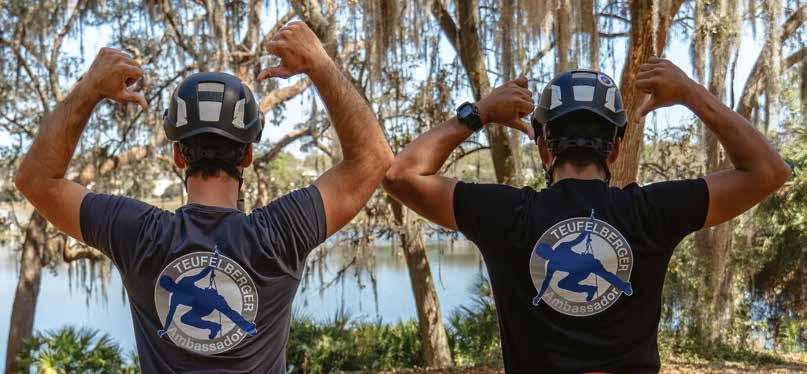
strengthen the team already made up of 24 climbers from 15 countries. His main missions will be to conduct workshops to promote good practice and safety, provide technical assistance to partners and resellers of Teufelberger products and promote all tree-related professions. It is likely that Chris will be supported by a second ambassador during 2023, stay tuned!
In 2022, Teufelberger is excited to launch two new treeMOTION Essential and Pro harnesses which replace the old S.Light, Standard and Evo versions. Teufelberger has collected over the last two years the input and feedback from hundreds of climbers, dozens of partners and 25 ambassadors in order to propose the best harness that Teufelberger has ever designed and manufactured.
For more information visit www.teufelberger.com
Teufelberger Treecare strengthens its position in Australia and signs a strategic agreement.


Arboriculture Australia’s recruitment campaign to tackle critical national skills shortage in vital green collar sector.
Career changers, school leavers and communities concerned about climate change are the focus of a new initiative to promote the value of urban trees and industry-wide job opportunities.
The Arborists Don’t Grow on Trees campaign launched by Arboriculture Australia is the industry’s response to a growing critical shortage of qualified and unqualified tree care workers.
Arboriculture Australia is the peak national organisation that represents arborists and promotes professional tree management and urban forestry throughout Australia and the Asia Pacific region.

“In the post-COVID economy, much talk has been about the nationwide labour
shortages across most sectors but our industry has struggled with significant skills shortages for years,” James Maund, Director at Arboriculture Australia, said.
“Arborist is one of 57 ‘occupations in national shortage’ in the top-most category
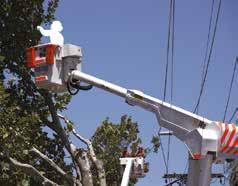
on the National Skills Commission’s Priority Skills list – all occupations rated as having strong future demand.
“But arborists don’t grow on trees, so we need to engage the community and focus on growing the next generation of tree care professionals. The urgency for this cannot be overstated.”
Despite the skills shortages, more and more urban tree canopy coverage is being mandated, as all levels of government have in recent years increased budgets and accelerated the roll-out of city tree planting programs on a wide scale, predominantly in response to climate change.
Even after tree planting programs are completed, ongoing maintenance requirements – including substantial safety and compliance objectives – mean significantly more opportunities in a range of roles, despite a huge shortfall in the number of skilled tree industry workers.
“Trees play an ever-increasing, important role in our communities: mitigating climate change and urban heat island effects; increasing the life of public infrastructure and property through better weather protection; sequestering carbon; increasing property values; improving health and promoting overall liveability of our cities and neighbourhoods,” Maund said.
“Equally, there are lifelong career opportunities available across a variety of beneficial and rewarding roles: helping improve local environments, physical work that promotes good health and working outdoors that also supports better mental health.”
Share the campaign across social media, using the hashtag #arboristsdontgrowontrees
For further information about Arboriculture Australia go to: www.trees.org.au
For more information, visit the website: www.arboristsdontgrowontrees.com.au

Safety eyewear has become an important and integral part of life.


It’s no surprise that over 60 per cent of eye injuries occur either at work or whilst participating in active sports.
No matter whether you’re at work, home or play, the high number of risks causing eye injury reinforces the need to wear quality safety eyewear.
In the dark but not too distant past, eye protection was ugly, clumsy and uncomfortable… and don’t even think about prescription glasses – those clumsy over specs that didn’t fit and obstructed vision. Luckily, thanks to innovations in technology, now you can purchase sexy eye protection that looks as good in the boat as it does at work – while still providing the best protection available.
There’s no ‘one-size-fits-all’ solution to eye protection. The frame and lens needed will be different from person to person, and from activity to activity.
Shamir OHS not only offers an extensive range of safety and sun eyewear for both prescription and non-prescription lenses, but
they also offer one of the largest available ranges of iimpact-resistant lens materials, high performance coatings, and frame technologies. Shamir OHS safety lenses are often made polycarbonate or Trivex® making them thinner, lighter, and ideal for long term wear… some even resist water or float!
Shamir OHS lenses are Australian made and made to Australian and New Zealand Safety Eye Protection standards meaning that not only are they designed and made by Australians, but they’re certified to keep your eyes safe during almost any activity.
Check out Shamir’s full range online at www.eyresbyshamir.com.au
function for quick cutting height adjustment, the 525PT5S features:
• Auto return stop switch which automatically resets to the ON position for trouble-free starting
• Intuitive controls – with easy reach of the choke and purge
• Robust magnesium clutch housing for tough professional use, ensuring a long service life
• Impact guard to act guard protects the engine from damages
Designed for professionals, the Husqvarna 525PT5S pole saw with telescopic shaft offers the longest reach, with excellent ergonomics and superior balance to help you achieve high-end results with minimum effort.
The 525PT5S pole pruner is easy to manoeuvre, while the X-Torq® engine ensures rapid acceleration and high torque with low emissions and low fuel consumption. With its intuitive controls and a telescopic
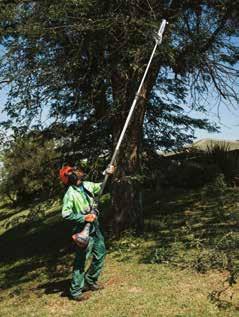
• Adjustable, automatic chain lubrication
• Easy starting via air purge
• Commercial grade 2-stage air filter which reduces servicing costs and also results in less engine wear
• Durable metal skid plate to protect the engine and fuel tank
• X-Torq® engine designed to reduce harmful exhaust emissions by up to 75 per cent and increase fuel efficiency by up to 20 per cent.
Valued at $1599 RRP, this great prize is up for grab for a lucky subscriber. Subscribe to The Australian Arbor Age for your chance to win this next great prize offering. Check out page 72-73 for the subscription value options. (Pricing correct as at 01/08/2022.)
If you’re in the market for a new telescopic pole saw, check out Husqvarna website: www.husqvarna.com


Thanks to our friends at Husqvarna, the 525PT5S Pole Saw will be the fantastic prize up for grabs for all the AA readers for the 2022-2023 draw.
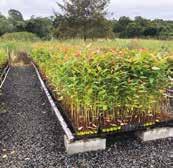
25,000 seedlings donated to support koala habitat tree planting programs.
Forestry Corporation of NSW has delivered 25,000 koala food tree seedlings to the Friends of the Koala’s Lismore nursery to support north coast koala conservation groups’ efforts to establish habitat on private land.


With wet weather rife across the region, all involved were relieved that the nursery site remained dry enough to receive the bulk seedling delivery in support of Friends of the Koala’s and Bangalow Koalas’ planting programs.
Forestry Corporation has donated a total of around 175,000 seedlings to conservation groups over the last four years to support community koala habitat planting programs, said Forestry Corporation Partnerships Leader Ryan Ellis.
“We’re proud to work with Bangalow Koalas, Friends of the Koala and the Port Macquarie Koala Hospital to help local communities improve existing habitat connectivity and create future food sources across the landscape,” Mr Ellis said.
“These projects are primarily on private or public lands outside of the State Forest estate.”
The northern NSW landscape continues to weather the current wet period, which has significantly affected volunteer organisations, local communities and industry.
“The ongoing work being carried out shows the resilience of these groups; they continue to accomplish great outcomes and are best
placed to support local projects,” Mr Ellis said.
This year’s delivery to Lismore was delayed due to flooding across the region, however the wet season and additional time in the nursery resulted in a healthy and more mature delivery of seedlings than usual.
“The stock we have received are in great condition and now stored safely at our Lismore facility for acclimatisation and hardening,” said Friends of the Koala Nursery Manager, Mark Wilson.
“Coordinating a delivery of 25,000 in one day was a big effort — many thanks to the volunteers who assisted on the day,” said Mr Wilson.
“I was nervous about how it was going to work out with the wet conditions and weather, but the operation went smoothly and the trees look great.”
The current wet conditions are causing issues for tree establishment projects in areas that survived initial inundation.
“The challenges we currently face include prolonged waterlogging, excessive grass and weed growth and access to some sites,” said Bangalow Koalas President Linda Sparrow.
“Part of this year’s seedling delivery will be used to repair and re-establish gaps created due to flooding damage and seasonal impacts.”
The mix of koala-preferred species this year includes Forest Red Gum, Tallowwood, Swamp Mahogany, Grey Gum, Dunn’s White Gum and Black Butt. These will be distributed between Friends of the Koala Lismore and Bangalow Koalas to areas of highest priority across current and future projects.
The seedlings were grown at Forestry Corporation’s Grafton nursery, which last year produced 3.2 million seedlings for plantation reestablishment. This year the Grafton nursery is on track to deliver 3.5 million seedlings for forest reestablishment in support of sustainable timber production.
To find out more about Forestry Corporation’s community partnerships, visit www.forestrycorporation.com.au

“The challenges we currently face include prolonged waterlogging, excessive grass and weed growth and access to some sites.”
Two mechanics from the same workshop in Hastings have found themselves as competitors in the Construction and Forestry Service Technician category of the second annual John Deere Technician Awards.
John Deere Australia and New Zealand Managing Director, Luke Chandler, offered his congratulations to finalists and workmates Stephan Ebert and Nick Fargher who are both employed at AGrowQuip NZ, Hastings.

The New Zealand technicians will now contend with four Australians for the coveted title of John Deere Construction and Forestry Service Technician of the Year.
“Technicians deliver services integral to the construction and forestry industry by not only providing vital backup support and remote diagnostics, but by empowering operators to get the most out of their machinery and technology,” Mr Chandler said.
“New Zealand is fortunate to have an enormous pool of brilliant technicians working across our forestry, construction and
earthworks sites, so these finalists deserve to be very proud for being named among the best in their field.”
The John Deere Technician Awards were established in 2021 to recognise the hard work and expertise technicians provide to the construction, forestry and agriculture industries across Australia and New Zealand, and their drive to support businesses to be their most efficient, productive and profitable.
In total, more than 100 nominations from across Australia and New Zealand were received for the Awards, with finalists competing in six different categories, including Agriculture Service Technician of the Year, Construction & Forestry Service Technician of the Year, Turf Service Technician of the Year, Service Apprentice of the Year, Parts Technician of the Year and Parts Apprentice of the Year.
The award winners will be announced at a special gala event on August 5, Brisbane, Australia.
New Zealand John Deere construction and forestry service technician of the year finalists
Stephan Ebert, AGrowQuip NZ, Hastings
Growing up on a farm in Germany, Stephan Ebert was always a curious learner and interested in fixing machines. He has worked across multiple industries and had worked with John Deere machinery in the past before he began his career as a John Deere technician at AGrowQuip NZ. Today, he thoroughly enjoys working across both the construction and forestry industries. The diversity of the Field Service Technician role has made Stephan passionate about his work and determined to continue to upskill himself to better service customers. With a personal motto that “there are no problems, just solutions” he has earned a reputation as a respected technician across customers within his 500 km service area, which stretches from Gisborne to the Wairarapa region.
Nick Fargher, AGrowQuip NZ, Hastings
Nick Fargher was runner-up for New Zealand Construction and Forestry Technician of the Year in 2021 during the inaugural John Deere Technician Awards, a recognition which served to inspire him this year. He has further expanded his remote diagnostics skills which helps empower operators to get the most out of their machines.
A proud father of two boys, Nick has been qualified for six years and said working on site, across some beautiful yet remote areas, was his “perfect office”. Nick has been instrumental in growing the aftermarket business across the lower North Island, which has recently expanded to require the hiring of another technician.
List of New Zealand finalists
Agriculture Service Technician of the Year Finalists (will compete for New Zealand only Award)
• Bryce Dickson, Brandt, Whangãrei, North Island
• Greg Bishop, Southland Farm Machinery, Mosgiel, South Island
Construction & Forestry Service Technician of the Year Finalists (will compete against four Australian technicians for a combined New Zealand/ Australian Award)
• Stephan Ebert, AGrowQuip NZ, Hastings, North Island
• Nick Fargher, AGrowQuip NZ, Hastings, North Island
Turf Service Technician of the Year Finalist (will compete against four Australian technicians for a combined New Zealand/Australian Award)
• Hayden Pollard, Brandt, Whangãrei, North Island
Service Apprentice of the Year Finalist (will compete against four Australian
apprentices for a combined New Zealand/ Australian Award)
• Joshua Alexander, Brandt, Whangãrei, North Island
• Logan Robertson, Southland Farm Machinery, Invercargill, South Island

Parts Technician of the Year Finalist (will compete for New Zealand only Award)
• Ben McShane, AGrowQuip NZ, Cambridge, North Island
• Megan Tree, Southland Farm Machinery, Gore, South Island
• Megan Foster, Southland Farm Machinery, Mosgiel, South Island

Parts Apprentice of the Year Finalist (will compete against four Australian apprentices for a combined New Zealand/ Australian Award)
• Deena Martin, Drummond & Etheridge, Ashburton, South Island.
For more info visit JohnDeere.com AA
Tree Radar Australia uses a ground penetrating Radar Unit to provide the only, completely non-invasive method of tree decay detection and tree root detection available in Australia.
RADAR
Tree Decay is a severe problem which can put all the structure around a tree at risk. With Tree Radar Units™ decay detection, Tree Radar can scan for decay in any tree regardless of its height. The Tree Radar unit can give an accurate read out of the severity of decay in a tree without having to penetrate the Tree’s surface.
Tree Radar Unit™ can detect and establish the root proliferation of a tree, this allows the arborist to inform developers of any structural or instability issues without the need for drilling or digging.
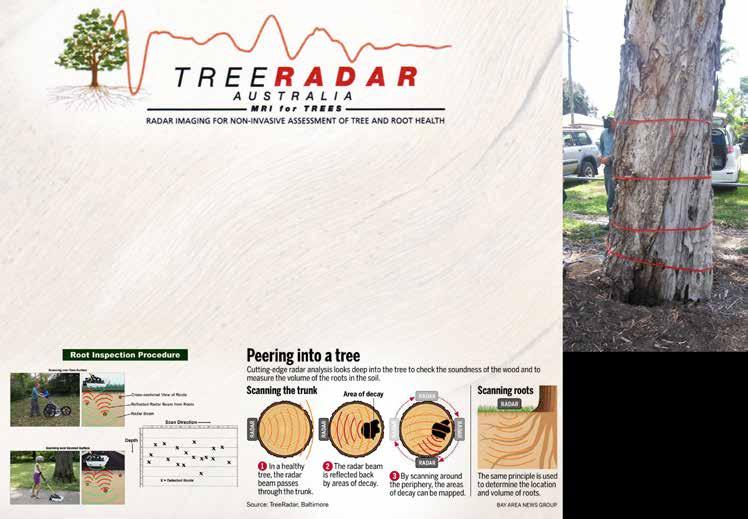
Iam excited to include the works of not just a fellow Arborist but a great Arboricultural thinker and practitioner – a man that supports a solid arboricultural business mostly by storm and ice (failure) proofing trees via light crown reduction.
He has little need for a fleet of large chainsaws or large-scale arboricultural machinery. I regard Ryan as one of the gutsiest arborists and best arb salesman I know, as he mostly runs a business out of retaining, maintaining and risk managing storm damaged veteran trees, trees which most other arborists condemn. Likewise in my experience, volume reductions that mirror the natural retrenchment process are all the veteran trees need for sustained longevity.
I met Ryan at the ISA 2013 Toronto Conference with Guy Meilleur. Guy and I sat together at a seminar on tree crown reduction. Following my questioning of the speaker on the depth of reduction being discussed (I have long questioned crown reductions on trees which cut beyond the sapwood), Ryan later approached to meet us and share a portfolio of before and after photographs – which detailed an exceptional body of work on the sensitive light canopy reductions that Guy and I both advocate in ours, all on the sustainable risk management of veteranised trees.
I am aware of a current, almost religious, movement in arboriculture where mathematical impassioned rhetoric relating to tree crown reduction is being used to disprove and discredit what a number of us experienced arborists see as experiential truth. Moreover, this truth is part of the very nature of trees. The ‘flagship’ that is being promoted here mathematically implies that crown reduction on trees accelerates biomechanical failure (to be credible, maths and experience must go hand in
hand). In reality, whilst retaining vitality (via sustained photosynthetic production) volume reductions, as I understand the art and experience, do the exact opposite.
In Ryan we had found a like-minded highly experienced specialist, in what I went on to call Tree Volume Reductions. In fact it was Ryan who coined that term, he went on to discuss the 5/30 rule (5% reduction in height = 30% reduction in volume) and even recorded the maths formula on a T-shirt he wore to the conference the following day. Guy and I were so impressed that following the conference and a solid invitation, we Joined Ryan on his climbing crew (we had bought our own kits from Guy’s US home in North Carolina) and did

a number of tandem 5 per cent pruning reductions (by hand tools) with Ryan in and around the city of Toronto.
Guy Meilleur (USA), Ryan Redvers (CAN), with UK and NZ representatives and I (for AUS) are part of a collaboration of Arborists that I call the Five Eyes of Arboriculture. To be honest I have no input on the maths, but like a number of arborists I have knowledge and experience of trees pre and post storm events. My 2008 Energex Gap storm report/AA article predated the formation of Biomechanics week in Ohio and coincided with published input from the Science of Ken James on trees. Though based on the experience of freshly gathering and presenting the data in that report, purely based on observation (mirroring Mattheck’s VTA) and then seeing Ken present on the nature of crown harmonics was the ultimate validation on why. Recognising the benefit for the balance of observation, experience and mathematics to support a natural world view on trees, I am very grateful for input by the likes of Ryan Redvers who shares this integrated vision in his. This is why I am now encouraging him to write feature articles for The Australian Arbor Age magazine. The following 2022 basic report of his is a prime example of his unique way of working and communicating on trees. Though he largely does contractual work, I see the need for him to do more in the way of the written, to share his wisdom and experience with the world. Note with Ryan’s permission, I have modified this report to make more of a feature article out of this introductory piece and to make it easier for study and reflection, though the heart of this work still has his great integrity. Cassian.
Ryan Redvers started his arboricultural career in 2000 and has been pruning trees in the Toronto area of Canada ever since. With a visual arts degree, and a love for math, physics, and geometry, he figured he had a good background for the task. The task being to understand and improve pruning concepts and practices. He has presented reduction pruning concepts at international and local ISA conferences.
His main goal is to master the skill of improving tree longevity and safety through gentle, thorough, and frequent reduction.
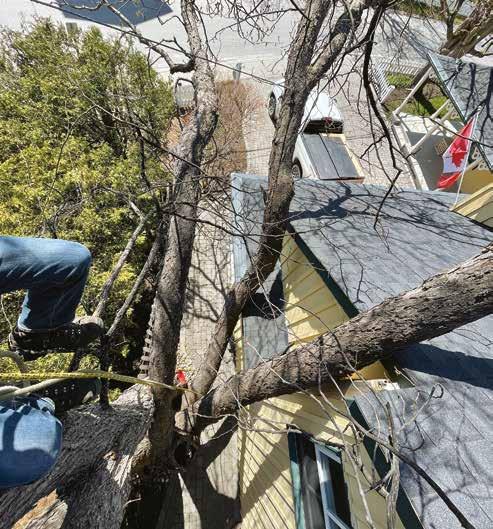
The primary Genera Ryan works on is Acer, but he also works on Salix, Juglans,
Fig. 2 Fig. 3
and other soft hardwoods. Remember scientifically “hardwood” doesn’t mean hard wood, it means dicot. A misleading error in terminology of many in the crossing paths of forestry and arboriculture.
The basic concept around his teaching is that arborists can intercept the natural pattern of failure in city trees, aiming for a means to mitigate or soften the wild pattern. Naturally, soft vigorous trees fail severely and infrequently, aligning with the pattern of storms. But we can fail them (cut them) frequently and mildly, creating stems which are more tapered and significantly more resilient. So instead of huge wounds into heartwood every 20 years, which mostly leads to decline, we have small wounds through more reactive sapwood which cause little to no stress. This doesn’t mean we stunt trees, we just mitigate the speed of their growth, avoiding slender, vulnerable structure, we train out the whip or the hotspots.
Basically, we give the tree a regular workout to prepare it for the big storm. Keeping the tree in check and not allowing it to naturally grow into vulnerability.
This does not mean we “play god”, it means we work with nature. Naturally, a forest regenerates its damage with ease. Longevity and durability is not as important for trees as it is for people. But people can “manipulate” trees to be longer lived and safer. In an urban setting, there aren’t several saplings ready to replace dead or failed trees. People need trees to get big slowly and live long. Not get big quickly, fail, then start over.
The concept and practice of this form of arboriculture is a win-win for trees and people. Ryan.

Arborist report – May 26, 2022
Prepared by Ryan Redvers, Toronto
This property has three trees of concern, but the main issue is the Horse ChestnutAesculus hippocastanum. The Sugar Maple in the front requires only minor deadwood removal. The issue with the common Horse Chestnut has been brought to the attention of the homeowner as a tree with potential risks. This multi-stemmed tree is on the east side of the home and is entangled with a smaller White Elm. The Elm is in good condition and requires no further comment or work. The Horse Chestnut tree is in good health, given the recent storm and history of humaninflicted damage endured. Unfortunately,
“Basically, we give the tree a regular workout to prepare it for the big storm.”
the previous overdose pruning done by the neighbour has left this tree with a higher potential for future damage than if it were pruned with an appropriate dose. The overhanging limbs were over pruned, as with the Black Walnut (to the rear of the property), with oversized cuts made right to the main stem (exposing/oxygenating the heartwood). Not an action or decision of the homeowner at 8 Platform Lane.
Unfortunately, our local by-laws lack better specifications of ‘injury’ to a tree. The potential higher risks to fail imposed on this tree by overdose pruning are partly due to the town’s lack of a better by-law (like all Greater Toronto Area towns) and the neighbour. Who is either unlikely to have been better informed by their arborist, or the neighbour failed to make a good choice with contractor selection. This is understandable given the commonality.
Many by-laws are formed largely from the example of Toronto’s by-law, which has great underground specifications but lacks specific definition of injury to the tree in an aerial sense. Such injury to a tree increases risk over time, cuts over 10cm should require a permit and or discussion. Due to weak vigour (ref: Shigogene code) chestnuts in particular do not react well to over-sized cuts. Black walnut has better natural vigour, but 30cm+ cuts are too much. Alternatively, where a limb has to be shortened beyond suitable reduction points, leaving a stub or length on the trunk (to trigger bud shoots) slows decay of the main stem, decay in the lower trunk is to impact the structural integrity of the remaining upper crown.
Current arboricultural practice largely revolves around reacting to the polarity of extremes and a misperception around aesthetics. Clearance is important but too much clearance is counterproductive, given
the plan to retain the tree long term, with good structural resilience.
The homeowner has practiced tree preservation and has impressive tolerance regarding the invasive position of this tree, rubbing on the house, which is literally built around one limb to accommodate the tree and avoid overdose pruning. Please refer to Fig. 2 and 3.
Fortunately, the risk is low as properly installed cables are in place to mitigate damage inflicted by the overdose pruning. Also, the event of failure involves medium sized limbs capable of minimal damage, only somewhat likely to fail during extreme situations like that which occurred across southern Ontario on May 21st, 2022.
The risk of failure can be made even lower with some reduction pruning applied to the most vulnerable areas of the tree. No further cabling or support is recommended.
The limbs close to and touching the homeowner’s building are of no concern. Annual attention can easily provide for a sound home and a sound tree. Reduction will reduce or eliminate rubbing, creating a stable point of contact rather than a rubbing point.
instead of on a stem with a canopy above. Removing small branches to the stem is ok. Removing limbs to the stem often causes higher risk, sunscald, decline, and poor long-term aesthetics. This is often referred to as lion’s tailing, which is known as improper practice. But again, a lack of better direction is not present and clear for the average tree worker and/or homeowner, so these errors are somewhat understandable.
Fortunately, the homeowner installed cables years ago, reducing risk. Risk can be reduced further with mild reduction to the portion of the crown above these oversized wounds.
Fig. 6 shows, encircled in red, the limb which arises from the significant decay point. The arrow points to the decay cavity. It is actually interesting that this long slender limb has held up. This limb should be reduced with a cut around 7-10cm In diameter and 2-3 meters in length. Including smaller cuts around the periphery of the remaining portion.
Fig. 7 shows the upper canopy and suggested reduction cuts. This kind of reduction applied to the entire crown will reduce storm loading in each limb, and the entire tree. Also, in the event of failure there
Fig. 4 represents the most significant exposed decay cavity. The limb on the left (overhanging the east neighbour’s) is not at high risk as it is already cabled. The stem on the right goes over the house it is touching and is supported by the cable and the house. The stem arising from the cavity is low and extends over the driveway almost to the sidewalk. This stem requires the heaviest reduction based on likelihood of failure in future storm events. Note - we can give credit for this trunk’s survival of the recent May storm.
Fig. 5 shows the overdose pruning, which is too common. A result of client demand and the lack of better information for arborists to mitigate this demand. A 3-5 meter limb should not be cut at the trunk. The better practice is to leave some length, any length, 30cm to 2 meters. For several reasons. In the event of failure, you create a cushion. More importantly, you decrease the likelihood of failure by creating a decay point off the stem
would be a better cushioning effect and less mass. The risk of this and every tree will always remain unknown to some degree, but considering the recent storm to date, mitigation has mostly been successful, and some level of risk is always acceptable.
Some trees can’t be retained with mitigation due to issues with vitality and/or structural limitations. The structural vulnerability (risk) of this tree is currently acceptable in my opinion but could be made even more resilient with some reduction pruning. Mostly mild reduction but heavy on the limb shown in Fig. 6 and 7.
• Significant reduction of lower limb growing from decay cavity, cut to 10 cm in diameter.
• Mild reduction of cabled limbs and remaining canopy, cuts up to 6 cm diameter.
• Removal of all deadwood over 5 cm diameter and most deadwood under 5cm, arborist monitor every two years as well as frequent visual attention by homeowner.
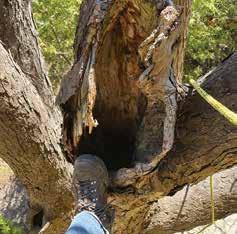
The limbs close to and touching the homeowner’s building are of no concern.
Fig. 5
A strength growing up was my ability to look for and find patterns, the wild pattern of failure in natural forests (by storm events and the like) is an abstract yet consistent one, whilst the frequent reduction pattern applied by arborists is predictable and civilized. Both patterns reduce slenderness but the latter does it smoothly (with smaller wounds) instead of abruptly.
The latter over-builds structure to easily handle the average storm and is failed only by extreme storms, or even only by the worst portion of extreme storms.
In our recent Ontario May 21st storm for example, the hardest hit spots (less than 1 percent of the area covered by the storm) were hit with 150 to 195 km/hour gusts (or accelerated wind gouges).
I believe even in those super-gouges that tree damage can still be mitigated, certainly that the trees which failed in the gusts ranging
Fig. 6 Fig. 7
100-150km could have been prevented.
The point is that a forest works well at a lower structural capability, an urban forest (garden) works much better with trees which are stronger and longer lived than the wild ones. Plus, expecting wild trees to adapt to the city (open grown) without proactive tree maintenance is a form of neglect. We in arboriculture owe it to the people and trees to do better. Ryan.
The experience of working with Ryan and Guy in Toronto, along with recording the work of another long-serving arborist and tree volume reductionist David Lloyd Jones (UK), was recorded with before and after shots in Part 3 of a 2015 past AA article series of mine entitled Tree Risk Management via Reduction Nutrition and Exclusion.
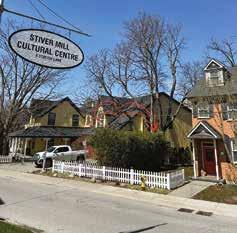


David, himself an arboricultural writer, is the founder of the principle he named RVT, Reduction Via Thinning. Likewise, he has a vast body of work which we will be sharing in future editions of The Australian Arbor Age David is also part of the collaboration we are calling the Five Eyes of Arboriculture.
Stay tuned for more on the essential topic of sensible and sensitive crown reduction on amenity trees. In time we intend to present our own mathematical contribution validating sensitive crown reduction works, though rest assured, if we can not use maths to validate actual collective experience we will not bother publishing, there is already more than enough academic rhetoric in the world that makes zero sense.
We look forward to hosting future articles by Ryan Redvers and David Lloyd-Jones. Cassian. AA
Professional indemnity insurance can provide cover for businesses and individuals who deliver professional services from the legal costs and claims for damages from an act, omission or breach of duty that occurs as a result of their actions.
This insurance may provide cover should:
• A web designer face legal proceedings after using an image for which it didn’t have a licence
• An architect get sued for creating a flawed house design after the owners had to pay to fix a flawed extension
• A marketing agency print a client’s brochure with incorrect contact details, resulting in the client commencing legal action against the agency
It’s important to understand how this type of cover works because many people don’t think it applies to them, when it can provide an important line of defence in many different circumstances.
1. Cover is available in many different industries
Don’t assume you can only take out professional indemnity insurance if you are a member of one of the traditional ‘professions’. You don’t have to be a doctor or a lawyer to take out this type of cover. In fact, anyone who is in a role in which they provide advice should consider whether professional indemnity insurance could provide protection from litigation.
A lot of people like plumbers and builders give advice, but don’t buy professional indemnity insurance. But they may be
exposed if a customer follows their advice to their detriment.
Anyone who gives incorrect advice that results in a financial loss, including accountants, solicitors, mortgage brokers, engineers and project managers need professional indemnity insurance. You can also be held accountable for not giving advice you would be expected to have given.
“While it’s important to appreciate risks for which you are not covered, it’s equally important to understand which policy extensions are available.”
they may reasonable have been expected to or neglect to provide you with a duty of care expected of a professional.
3. Professional indemnity insurance only provides cover when the policy is current
Professional indemnity insurance only covers policyholders while a policy is live. So, if you take out a policy, then let it lapse, you won’t be covered for claims that concern events that happened when the policy was active.
2.
Not only can someone face legal proceedings for giving incorrect advice that causes a loss, a professional may also be sued for not giving advice that is reasonably expected of someone working in their field.
For instance, doctors may be sued if they fail to diagnose you are suffering from an illness, decline to send you for a scan when
This means professionals should consider whether they need to maintain professional indemnity cover even when they retire. In some professions, for instance accounting, there is a requirement to maintain cover even when you retire or leave the profession.
4. Understand any exclusions
Professional indemnity insurance is a complex area and many insurers won’t cover certain risks in policies. For instance, most insurers won’t cover builders and other

entities in the construction sector for any damages that relate to building cladding, given the problems many strata buildings have encountered with flammable materials.

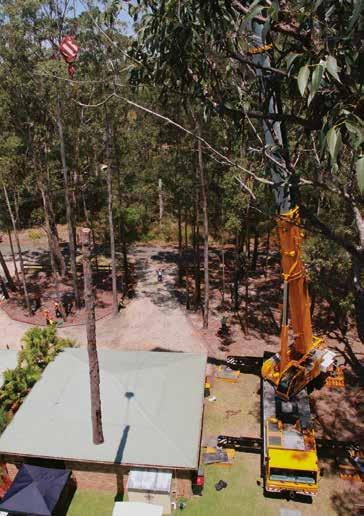
This means it’s essential to read the fine print in policies and develop a real understanding about which professional risks are covered and which are not.
While it’s important to appreciate risks for which you are not covered, it’s equally important to understand which policy extensions are available.
For instance, many policies will include extensions for investigation costs in the event a claim is made against a policyholder and he or she needs to retain legal services.
“It’s also essential to understand the policy’s retroactive date”. This is the date from which the insurer has agreed to provide cover. It is recommended to negotiate unlimited cover.
As this shows, professional indemnity insurance is complex and it pays to work with an experienced insurance broker to help you get the right cover for your circumstances. That’s the best way to
ensure the policy responds when it comes time to make a claim.
This information is to assist you in understanding some of the terms, implications and common considerations with professional indemnity insurance.
Fitzpatrick & Co have specialised in the horticulture and arboriculture industry for over 30 years providing assistance and financial support to companies, associations and events. We are there when your industry needs you.

For more information or questions on Professional Indemnity insurance or your own policy, contact Fitzpatrick & Co. Insurance Brokers on (03) 8544 1636 or email: insure@fitzpatrick.com.au. Also visit www.fitzpatrick.com.au AA
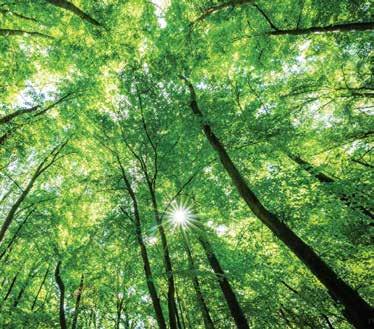
“While it’s important to appreciate risks for which you are not covered, it’s equally important to understand which policy extensions are available.”

Promoting safety within the arboricultural industry is one of our primary goals here at QAA. Currently arboricultural work (arborist) is in the top three most dangerous industries in Australia with almost every task assessed as a high hazard potential with risk of serious long-term injuries. Despite this there are no arborist specific Codes of Practice that are legally enforceable for safety breaches.
Members of our community have expressed their strong desire for this to change which is why representatives from the QAA Executive Committee recently met with Queensland’s Minister for Education, Industrial Relations, and Racing, the Hon Grace Grace, to present a report on the current state of the industry and to discuss the lack of safety regulations for arborists.
The meeting was a huge success with Ms Grace being understanding of the need for regulation and fully receptive to the ideas proposed. The team also provided some good feedback and requested additional documents which have been provided.
While this will be a long process, the meeting was a very productive first step towards developing arborist specific Codes of Practice. Next is a meeting with Di Farmer MP (Queensland Minister for Employment and Small Business and Minister for Training and Skills Development). There will be many more meetings with state and federal ministers to come as we move forward with our goal of making the industry safer for each other.
Our new sponsorship year kicked off in July. We welcome back and thank our legacy sponsors who have joined us again in 2022:
• Industry Support Partners: Fitzpatrick & Co Insurance Brokers and Vermeer Australia
• Education Sponsors: Husqvarna and Vermeer Australia
• Gold Sponsors: Bandit Tree Equipment, Husqvarna and Powerclear
• Silver Sponsors: ETS Vegetation Management and Treescape
• Bronze Sponsors: Mooncog
We still have a few spots left for new sponsors who would like to show their support for the QAA and the arboricultural industry. If you are interested in learning more about our Sponsorship Packages, please contact the office on 07 3821 1488 or email office@qaa.net.au.
Pest and Disease Damage Workshop
Thank you to those who attended our Pest and Disease Workshop with Janet McDonald from DFAT on Monday 16 May. The day was a successful one with Janet presenting industry relevant pest and disease information in an informative and relatable manner. Topics covered in this half day workshop included types of damage, leaf chewing, tying and pathogens, insect and fungal gall-forming, sap sucking, stem/branch boring, cankers, root pathogens, nutritional disorders, and exotic/biosecurity agents.
Janet’s wealth of knowledge and passion for the environment was clearly evident to all those who attended the workshop. Thank you, Janet, for sharing your knowledge with us.
“Got a few good nuggets from this.” Sometimes our best reviews come in just a few words.
Despite a somewhat chaotic lead up, our Soil Science for Urban Green Spaces workshop on Wednesday 1 June was a success with lots of information and tips given to the attendees.
In recent years, our local urban trees have been hammered with extreme weather events, alternating drought, heat waves, and floodings, adding more stress on top of their already constraint growing conditions. All of this is making soil health more important than ever.
During the workshop Soil Microbiologist, Katia Plouznikoff, took the attendees through a range of topics including soil nutrition, the process of testing soils and samples, collecting samples and how not to contaminate them, where to get samples tested and, of course, soils assessment.
Thank you to those who attended as well as our wonderful presenter, Katia, on delivering such a well-received workshop.

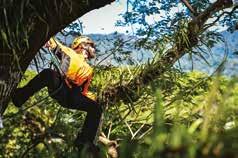

The Queensland Tree Climbing Championships (QTCC) are the pinnacle of our tree climbing competitions. This is a popular event with some of the best climbers in the country testing their skills at QTCC each year for the chance to be crowned the best climber in Queensland. This year’s QTCC will be held on Friday 23 and Saturday 24 September. All levels of climbers are welcome from rookies to professionals. Don’t miss the chance to put your practice to work by showing us what you’ve got. Thanks to our event sponsor, Husqvarna, ticket prices are low to encourage more climbers to be involved. Additional discounts also apply for QAA members. For more information scan the QR code on this page, visit the QAA website or follow our Facebook event.
Planning is well underway for our 30 Year Gala Dinner at the Hotel Grand Chancellor Brisbane on Saturday 19 November, 2022. In addition to celebrating 30 years of the QAA and providing an opportunity to catch up with industry colleagues, the dinner will also include presentation of a number of awards. These are:
• Apprentice of the Year
• Mentor of the Year
• Best Picture Award
• Sustainable Practices Award
• Industry Innovation Award, and
• Lifetime Member Award.
Nominations for the awards are now open and will close on Friday 2 September, 2022. The names and nomination reasons of the top 5 shortlisted nominees will be published on the QAA website in October to be voted on by the public.
The winners will be announced at the QAA 30 Year Gala Dinner on Saturday 19 November. To submit a nomination, visit https://qaa.net. au/about-us/qaa-30-year-gala-awards/. Tickets for the dinner are now on sale. Check out the events page on our website to book your seat.

For info call QAA on (07) 3821 1488, email office@qaa.net.au, or you can go to www.qaa.net.au. Follow us on Facebook (QueenslandArboriculturalAssociation), Twitter (QLD_Arb_Assoc), Instagram (qaa_arborist), LinkedIn (queenslandarboricultural-association) or via the QAA App. AA

Safe Work Australia has published WHS information for PCBUs and workers who are working as part of a contractual chain.
Did you know that an individual contractor or a self-employed person can be both a worker who is owed work health and safety (WHS) duties, and a person conducting a business or undertaking (PCBUs) who may owe WHS duties to themselves and to other workers?
Safe Work Australia has published WHS information for PCBUs and workers who are working as part of a contractual chain.
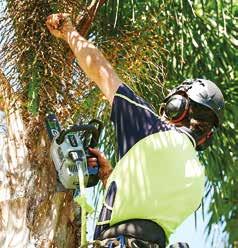
The fact sheet provides an understanding of what a PCBU is and explains that an individual contractor can be both a PCBU and a worker. Understanding this will help PCBUs within a contractual chain uphold their WHS obligations and consult, cooperate and coordinate activities with all other PCBUs with whom they share a duty.
Contracting is when a business engages another business to carry out work under contract. A contractual chain refers to the situation where, in relation to the same project or work matter, there are multiple contractors and subcontractors. There can be several levels in a contractual chain.
For example, a client may engage a head contractor to deliver a logistics project. The head contractor may engage contractors to undertake parts of the project, and these contractors may engage subcontractors to carry out particular activities that the contractor is to deliver. It is good practice to understand if you are part of a contractual chain as it will help you understand who you may owe WHS duties to and who may owe you a duty of care and allow for necessary consultation about these duties.
The primary duty holder under the model WHS laws is a PCBU. The term PCBU covers a broad range of modern work relationships and business structures. A PCBU can be an employer, a sole trader, self-employed person, company or corporation, association or government.
As a PCBU you have a duty under WHS laws to ensure the health and safety of workers and others who may be at risk from work carried out at the workplace.
You must:
• eliminate risks so far as is reasonably practicable, or if this is not possible, minimise risks so far as is reasonably practicable
• provide and maintain a work environment that is without risk to the health and safety of workers
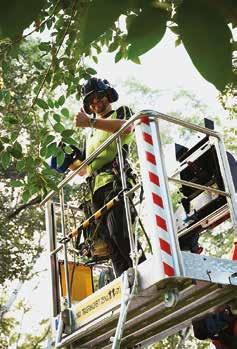
• provide adequate and accessible facilities for the welfare of workers to carry out their work, and
• give workers the necessary information, instruction, training or supervision to do their job safely and without risks to health.
PCBUs may also have other duties in addition to their primary duty of care. This includes duties relating to the management and control of workplaces, duties relating to the design, manufacture and import of plant and substances, duties to consult, and duties that apply to principal contractors on construction projects that involve construction work of $250,000 or more.
For more information about who may be a PCBU and their duties visit www.safeworkaustralia.gov.au/law-andregulation/duties-under-whs-laws/dutiespcbu and refer to www.safeworkaustralia. gov.au/resources-and-publications/ guidance-materials/health-monitoringpersons-conducting-business-orundertaking-pcbu-checklist AA



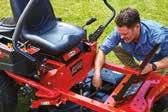


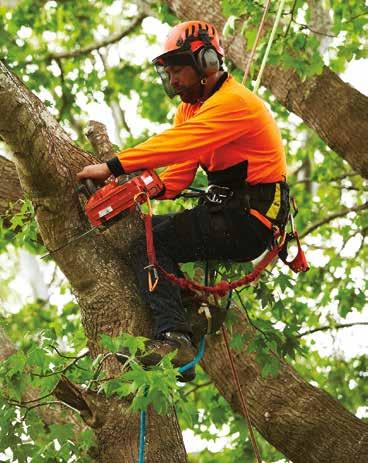

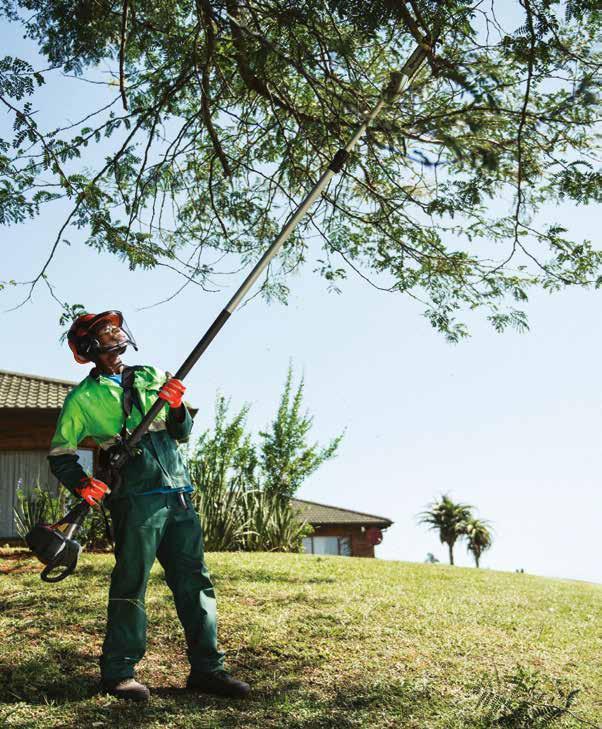
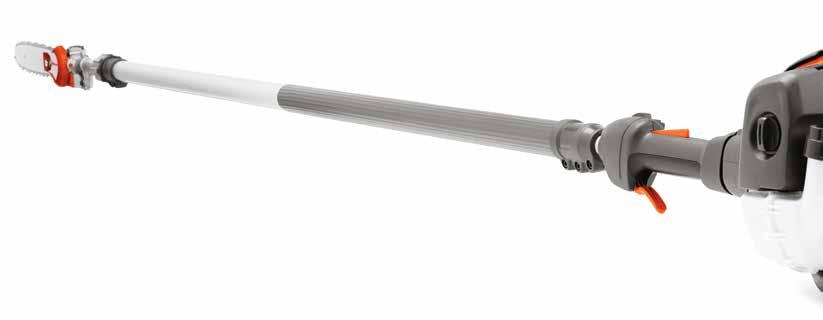

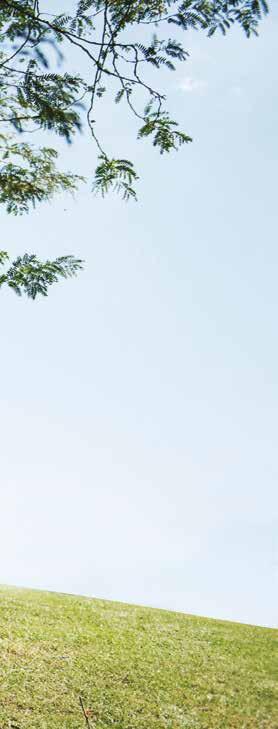
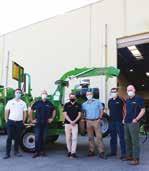
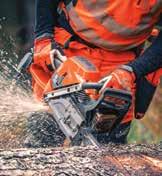
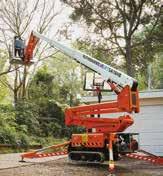
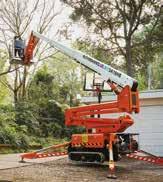






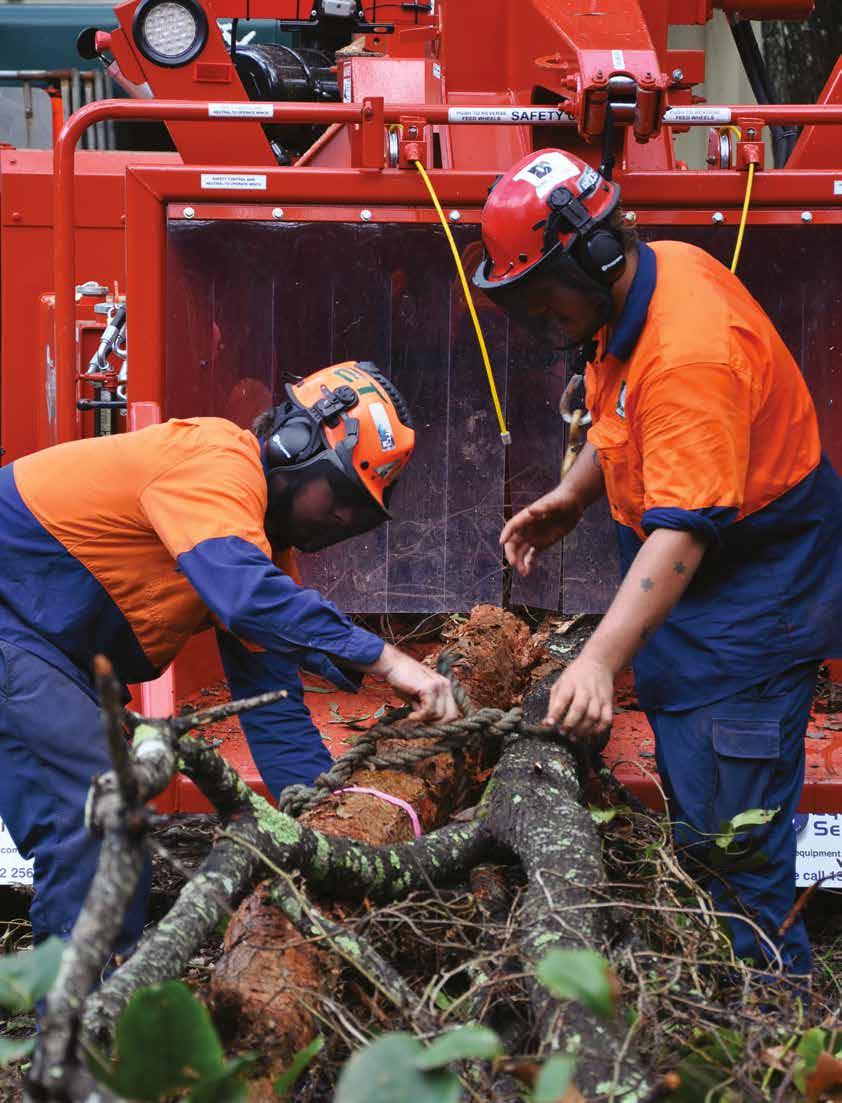

Active Tree Services are reaching beyond the rest to create a workplace that offers more than just an exciting and diverse day job.
Active recognises that its people are its most valuable asset and main contributor to the company’s success. Active have introduced a compelling employment package across a wide scope of positions, from entry level to management, that are available now.
To achieve its status as Australia’s leading vegetation management company, Active invest in the growth of their team, their skills and experiences. The opportunities for career growth helps to attract and retain the right people for their professional and dynamic
team of safety and vegetation management experts. Active offers both long term job security through its position as an essential service provider, whilst also enabling professional growth and development through nationally recognised training.
As team members within Active consistently develop and grow their skills, the dynamic of this family owned and operated business means that individuals who are passionate about this industry have a real opportunity to become a key part of the team. From executive and supervisor roles, to establishing subcontracting relationships within key geographic locations, Active have positions that provide career pathways for every level of experience.
As the scope of work grows, so does the Active team. Join the team responsible for maintaining safety for our communities, and experience the culture that sends their team home safe every day.
Active provides subcontractors with equipment, business expertise and professional support for those looking to start their own business or help grow an exisiting business. This is an incredible opportunity for subcontractors to utilise the strengths that only a company like Active can offer.
The benefits for joining the Active team are extensive and growing by the day. With support for development, hybrid working opportunities, above award wages, the ability to work across different states on a temporary or permanent basis, and benefits from relationships with external parties, there are many incentives and benefits that come from being an Active team member.
Active works hard to ensure they have a great offering by providing innovate equipment, training, benefits and development for its people. Feedback is encouraged to ensure Active remains “a great place to work”.
Across the business, apprenticeships and traineeship are an important part of the fabric of the company. With 50+ apprentices and trainees currently undertaking study, the benefit is gaining excellent work experience in a supported and knowledgeable environment. This has resulted in high levels of completion rates and ongoing employment within the business.
For new people joining the industry, considering something completely new can be daunting. With safety systems, process, and support from industry experts, new employees feel supported and safe in this environment. Full training, equipment, personal protective equipment, and licenses are provided to all new entrants during this learning phase.
The Active team is working through a process of initiating an internal pilot program to develop AQF5 certified team members. The process has been outworked as an expression of interest to enable all employees to apply for a position. Support will be provided to the successful applicants via time, money, mentoring and coaching to set people up for success.
So “Make Australia your Office” and apply to work at Active today!
Active is a great place to work and with careers, training, support, mentoring, guidance and security, there has never been a better time to join the team.
Check out available careers at www.active.com.au or scan the QR code on this page. AA
Arborcraft Tree Services, a Melbourne-based arborist and tree maintenance company, has seen steady growth since they started 10 years ago, which has led them to purchase a brand-new Vermeer BC2100XL woodchipper.


Sam Pusey founded Arborcraft as a oneman band. Now he has a staff of 25 and a diverse range of projects the business contracts out for. “I remember having to cart my chainsaw up the stairs of my apartment block each day. Now, we’ve got our own six-acre facility, where we recycle wood and mulch, and I have room for much more equipment,” he says.
“I think our growth has a lot to do with backing ourselves from the start, investing in our people and delivering 100 per cent for our customers.”
Sam and Arborcraft started doing simple residential tree work, removing branches and stumps, fine pruning and confined space tree removal, but now they focus on more largescale commercial projects for both private companies and the state government – from tree management and tree reports, to tree transplanting, tree planting and removals, as well as habitat creation.
“We have contracts and projects right across the state, and we’re slowly building a presence in NSW. Our vision is to be a one stop shop – and that’s not just a slogan, we want to do everything and be there to support our customers. Focusing on growth will help us achieve that,” Sam says.
Part of this growth saw Sam purchase a brand-new Vermeer BC2100XL woodchipper, which is engineered for high volume waste timber processing and able to process timber up to 21 inches (53.3 cm) in diameter.
“The production of the machine is just quality. It might have a small engine, but it has high output with low emissions, something we’re very passionate about – ensuring our business is being sustainable where it can be.
“The safety features also really tick the boxes. Historically, tree machinery has been
quite taxing on our bodies, as operating the machine can be labour intensive, but the remote-control option with the BC2100XL has helped us manage that, making using the machine less demanding, and more productive for us.”
The remote control on the BC2100XL operates forward, reverse and stop functions for the feed rollers, restarting the feed rollers, plus engine throttle, engine stop, and crush boost for the upper feed roller and hydraulic discharge chute positions (if equipped), meaning operators can still work the machine from a safe distance.
Sam purchased the woodchipper from his
local Vermeer
in Melbourne, and based on his positive experience dealing with Marcus Scott and the Melbourne team he will soon be adding more Vermeer’s to his fleet.
“The service and response rate has been great. I have a real open and honest relationship with our rep Marcus, and even with the guys in the workshop. When I picked up the machine, I had my own dedicated service tech looking after us throughout the whole service and delivery period,” Sam says.
The reach and coverage of Vermeer’s support has also been a positive for Sam and Arborcraft.
“Recently we were working a job three and a half hours out of Melbourne, and had a small warranty issue on the chipper, nothing major, but enough for us to stop work. Vermeer had a tech out to us in an hour and a half from one of their other branches, and we were back up and running in no time.”
Want to find out more about Vermeer’s tree care range? Head to the website: vermeeraustralia.com.au/tree-care-arbor/
New Cat® mulchers bring reliable performance, easy maintenance and keep safety a priority.
Two new Cat® mulchers for tracked and wheeled excavators and forest machines deliver reliable operation in tough forestry applications. With their easy-to-maintain design, these mulchers incorporate a number of safety features to protect both workers and equipment at the jobsite. With the addition of the new Cat HM3013 and HM5515 models, Caterpillar now offers a mulcher attachment for Cat frontreach machines from 11 to 36 tons (10 to 32.7 tonnes) and long-reach front machines from 40 to 52 tons (36.3 to 47.2 tonnes).
The HM3013 has a new dedicated bite limiter drum, while the HM5515 offers a
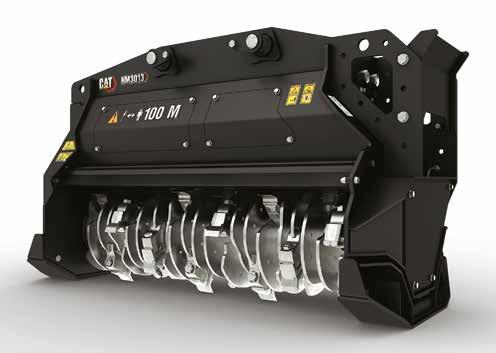
standard drum. Featuring an aggressive edge of the blade with the limiter and counter knives, the dedicated bite limiter of the HM3013 produces an exceptionally fine final product. The bite limiter drum design excels in mulching applications where rocks are minimal with large amounts of standing timber.

Key components on the mulchers factor into their consistent, reliable performance. The variable torque hydraulic piston motor shifts between high speed, low torque and low speed, high torque to deliver speed when it’s needed and power when it counts. Hardened counter blades mounted inside the housing help break down the finished material, which can increase the rate of composting.
Maintaining these new mulchers is fast and simple. Multiple service panels on each model provide easy access for quick adjustments. Further simplifying maintenance and reducing downtime, internal components can be easily removed in the field through the access panels. The poly chain belt drive transmission eliminates slippage on startup, increasing reliability and reducing maintenance costs. Most of the wear parts are made to be field-
replaceable to keep the HM3013 and HM5515 working at peak efficiency.
The ability to adjust the hydraulic mulching door allows the operator to control the material throw, increasing operating safety, especially critical on roadside clearing applications or when working near powerlines. Ground-level primary grease points increases daily maintenance safety. Bolt-on, replaceable skids keep the mulcher from digging into the ground or into materials that can increase wear or cause damage.
A complete list of mulchers, available by region, is available from the local Cat dealer or by visiting cat.com.
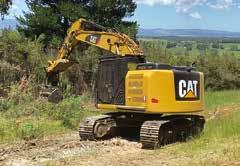
For more information get in touch with the Cat® team:
NSW/ACT WesTrac - 1300 881 064
VIC/TAS William Adams - 1300 923 267
Western Australia WesTrac - 1300 881 064
QLD/NT Hastings Deering - 131 228
South Australia Cavpower - (08) 8343 1600
NZ TERRA - 0800 93 39 39
Since launching in 2013, Först have rapidly become the market leaders for commercial woodchippers throughout Europe. The brand has become a firm favourite for arborists, rail contractors, local authorities and rental/hire companies thanks to their absolute focus on performance and reliability, as well as being the first company in the industry to offer a three-year, no quibble warranty on all machines.
Först chippers are now available throughout Australia thanks to an exclusive distribution deal with Global Machinery Sales. Global Machinery Sales supplies the arboriculture, forestry, access, construction and landscaping industries with machines including woodchippers, stump grinders, spider lifts, spider cranes and forestry mowers across the country from their locations in Melbourne, Sydney and Brisbane.
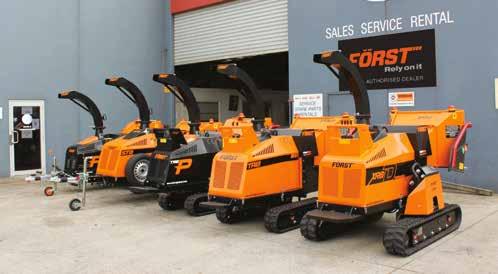
Global Machinery Sales offers both wheeled and tracked Först chippers, but has noted that Australian customers are particularly interested in the ST8D and ST6P models.
“One thing I hear a lot from contacts in the arb industry about Först chippers is ‘wow,
someone has put some serious thought into these machines.’ The access to the engine, grease points, blades and variable speed controls are all designed around the end user, making service and maintenance easier,” says Brian Evans, Director at Global. Boasting 45 horsepower with a huge amount of torque and phenomenal performance, the Först ST8D makes light work of any type of timber and brash up to 8" in diameter. The ST8D is fast, aggressive and powerful with its Kubota diesel engine delivering exceptional fuel economy. The
chipper is compact enough for the city, yet offers performance comparable to machines twice it’s physical size.
The Först ST6P is the fastest, most aggressive and most robust machine in its class making it the best-selling 6" capacity petrol woodchipper in the UK and Europe. At the heart of the machine is the industry renowned FörstGrip feed roller system and Först flywheel system giving this machine unmatched performance in processing all types of material.
Brian’s son Sam Evans, who also works in the business as the General Manager shares this feedback from an ST6P customer: “The customer came back saying that the Först machine did the job in half the time of the last chipper he’d rented – he was really pleased with it.”
The reliability and ease of maintenance for Först machines makes them ideal for arborists undertaking any type of work. Add to that their robust build quality and resulting ability to take a pounding from the most reckless of customers, why not consider adding Först machines to your fleet today?

For more information, please call Global Machinery Sales on 1300 072 926 or visit globalmachinerysales.com.au
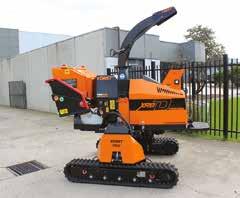
Först chippers are now available throughout Australia thanks to an exclusive distribution deal with Global Machinery Sales.
The full range includes compact, wheeled and crawler excavators. All excavators in the series are extremely versatile and highly adaptable to their tasks. They can be used for everyday earthwork jobs to heavy forestry mulching or rehabilitation work with minimal adjustments.
“The E Series comes with Stage 5 ‘emission control’ engines – the latest technology engines and the cleanest engines currently in use in Australia,” says Lindsay Daniels, CJD Equipment’s National Product and Training Manager.
“It also has an electronic platform, which allows the E-Series to carry Volvo’s unique Co-Pilot system. This android-based system has a variety of applications and in an excavator, it has the ability to carry the Dig Assist program along with apps like maps and weather. It puts the control of the machine in the operator’s hands,” he says.
The E-series is designed to further increase operator comfort and machine durability while optimising fuel consumption.
“The hydraulic system is designed to reduce the load on the engine, which helps reduce fuel consumption. It has adjustable flows and pressures from inside the cab,” Lindsay says.
“Positive control hydraulics and pump input torque provide increased productivity through a high-pump flow. Combined with an electrohydraulic control system, the high-pump flow creates faster response and cycle times. The beauty of Volvo engines is they produce a high amount of torque at very low revolutions per minute, so you don’t have to rev the engine, thereby saving fuel and keeping noise pollution down,” he says.
“Volvo’s unique ‘eco’ mode optimises the hydraulic system to reduce flow and pressure
losses, resulting in improved fuel efficiency without any loss of performance in most operating conditions.”
The E-series range also comes with the option of the latest Dig Assist technology.
The Dig Assist system allows operators to input job specifications, providing real-time guidance to ensure projects are completed quickly, more accurately and with improved site safety. Volvo’s Co-Pilot system with Dig Assist is available on all 14 to 48 tonne crawler excavators and short swing excavators ECR145E, ECR235E and ECR355E.
“The E-series range is powerful and efficient, like all Volvo excavators, but its human machine interface design, which streamlines all in-cab features ergonomically to produce increased operator productivity, really sets it apart. The body-centric design is integrated into everything from joysticks and LCD screens to keypads and hot keys,” Lindsay says.
In designing these machines Volvo has ensured that both operator safety and ease of maintenance remains key. The operator can control pressure and flow within the auxiliary function through the cab, with 20 separate pre-set functions. The smart cab design also
Volvo’s tracked excavators set higher standards of value and excellence in the forestry industry. A heavy-duty, reinforced undercarriage, with a robust boom and arm that includes internal plates positioned to support pressure points, Volvo machines are specifically designed for the forestry industry. Volvo’s ROPS cab with a reinforced steel structure ensures the operator is protected, while also meeting the ISO standards for safety, these are the ultimate machines for even the toughest of jobs.
When you choose a Volvo you not only get world-class forestry equipment, you also get full support from CJD Equipment. With a national supply network and 24/7 after hours call out service, you can rest assured you are well supported. Thanks to their vast network of branches and service centres that stretch across the nation, whether you need parts or service, you can trust your local CJD Equipment team to deliver.
For more information about Volvo CE equipment, visit the CJD Equipment website cjd.com.au
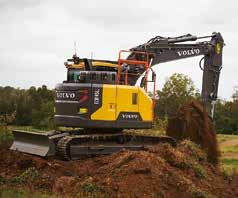

Made in the USA using premium quality steel, Fecon products are engineered and constructed with unmatched durability and power to tackle any Australian timber. Furthermore, with Fecon Australia – your national supplier of the full range of Fecon forestry equipment – customers throughout Australia receive world-famous forestry machines backed by only the best local service, support, parts and sales.
Perhaps the most legendary member of Fecon Australia’s attachment family is the iconic ‘Bull Hog’ mulching head. Designed to be powerful and versatile, Fecon Bull Hog mulchers are perfectly engineered to suit a wide variety of track and skid steer loaders offering anywhere from 53 up to 191 LPM of hydraulic flow, plus mini and large


Fecon is one of the world’s premier manufacturers of forestry attachments and machines, globally renowned for building the toughest attachments in the industry.
excavators sized from five tonne and above.
Fecon Bull Hogs satisfy the three key requirements in a forestry mulcher: durability, performance, and value for money. Innovative engineering, premium quality steel throughout, reinforced rotors and mulching teeth and exceptional welding processes combine to deliver strength and longevity. Variable motor speeds also maximise the overall performance of Fecon mulchers. For lighter material loads, higher RPM means more bites per second and finer material sizing – whereas with heavier material, the Bull Hog delivers more rotor torque keeping the rotor turning when other heads may stall.
Fecon Australia also offers a diverse range of vegetation management attachments, including the revolutionary low RPM
Stumpex for skid steers, track loaders and excavators; an auger-style stump grinder that uses slower, yet more efficient, grind rotations to minimise mess and deliver a clean end product. Furthermore, Fecon’s innovative tree shears are perfectly designed and constructed to nimbly shear, lift, bunch and carry multiple trees with a single attachment, also compatible with CTLs, SSLs and excavators.
Finally, if you need a machine plus attachment combination ready to tackle even the most challenging land clearing project, Fecon Australia’s range of forestry tractors are simply unmatched for quality, performance, and durability. Ranging from
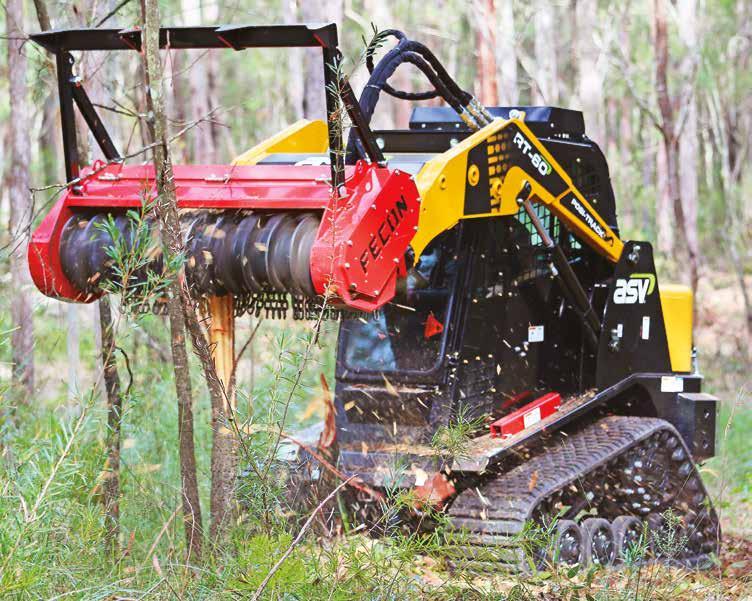
the 140 horsepower FTX150-2 up to the absolute beast 600 horsepower FTX600, Fecon Australia’s machines are made to perform. Complete with ‘severe duty’ high flow hydraulic Bull Hog mulching heads, no job will stand in the way of a Fecon forestry tractor.
Fecon Australia also offer a nationwide parts, service, sales and support network for all machines and attachments, ensuring that any scheduled or unplanned downtime is resolved quickly and easily. Don’t wait weeks for replacement parts or service requests as is standard for many forestry equipment suppliers in Australia – Fecon Australia will have your support needs catered to swiftly and efficiently.
For more info about Fecon Australia’s range of forestry machines and attachments, visit www.fecon.net.au or call the national information line on 1300 332 661. AA
On 15 June 2022, the Fair Work Commission minimum wage panel announced the 2022 annual wage review decision under the Fair Work Act 2009.
The FWC has applied wage increases as follows:
• $40 per week (5.2%) to the national minimum wage
• $40 per week to award wage rates up to and including $869.60 per week;
• Increases of 4.6% to award wage rates above $869.60 per week.
This year’s increase is the highest wage increase in more than a decade. In its Decision the FWC took into account the position of various parties, the ACTU’s claim of 5.5%, the ‘peak’ employer group positions, the AiG (2.5%) and ACCI (3.0%), and the submissions of the new Federal Government which argued for an increase of 5.1%. The FWC noted the ‘sharp increase’ in inflation, and the reductions in unemployment and underemployment.
The FWC concluded that the changes in economic conditions justified the increase awarded, although noting the 0.5% increase in superannuation effective 1 July 2022.
The decision increases the national minimum wage by $40.00 (or 5.2%) from
$772.60 per week to $812.60 per week based on a 38 hour week, or $21.38 per hour. For award covered employees, the minimum wage rates in modern awards up to $869.60 per week were also increased by $40.00 per week, and minimum wage rates above $869.60 per week were increased by 4.6%.
For most modern awards the wage increases were effective from the commencement of the first full pay period on or after 1 July 2022. Please note: The Superannuation Guarantee was increased to 10.5% from 1 July 2022.
Tree Contractors who are existing TTIA Members received updates to existing pay and allowance summaries outlining the impact of the wage review on awards that apply to the timber products industry.

If you are a Tree Contractor and not a TTIA Member, you are invited to contact the TTIA Employers Hotline on (02) 9264 0011 or email ttia@ttia.asn.au if you require further information re membership.
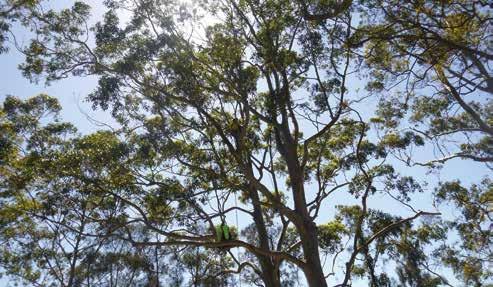

The highest wage increase in more than a decade.
Brian Beecroft, Chief Executive Officer AA
“For most modern awards the wage increases were effective from the commencement of the first full pay period on or after 1 July 2022.”
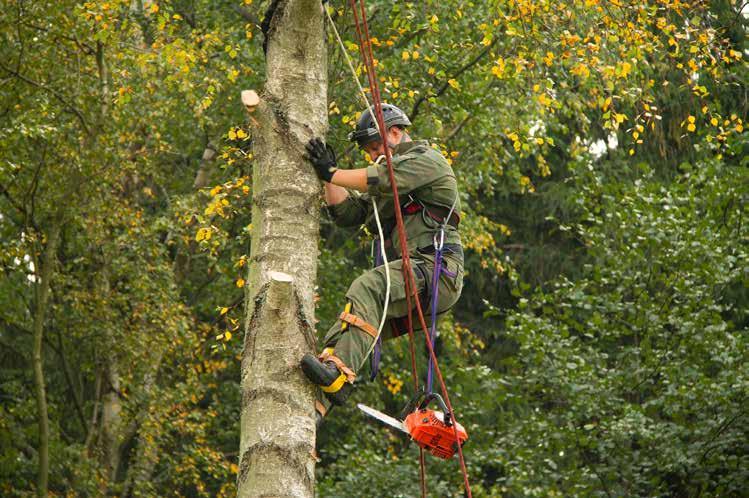

Customer satisfaction is our #1 goal. Luke from Tip Top Tree Services is a testament to that. After doing his research on a new chipper and stump grinder last year, Luke couldn’t go past the after sales service from Bandit. “We’re stepping up our equipment, we’ve had other chippers in the past. But I’ve never seen anything match the Bandit,” says Luke. A new 18XP chipper was added to the Tip Top Tree Services fleet at the end of 2021, and now a new SG-40 stump grinder is ready to go as well. “I thought I’d make the change and give it a go. And I’ve been happy so far which is good,” says Luke. Customers like Luke are the reason why we love what we do at Bandit. Our goal is simple. To ensure you have an outstanding experience with your Bandit chipper or stump grinder every day. Our team is here to support your success. Welcome to the Bandit Family.
NSW/ACT
Bandit Tree Equipment 1800 681 733 www.banditchippers.com.au
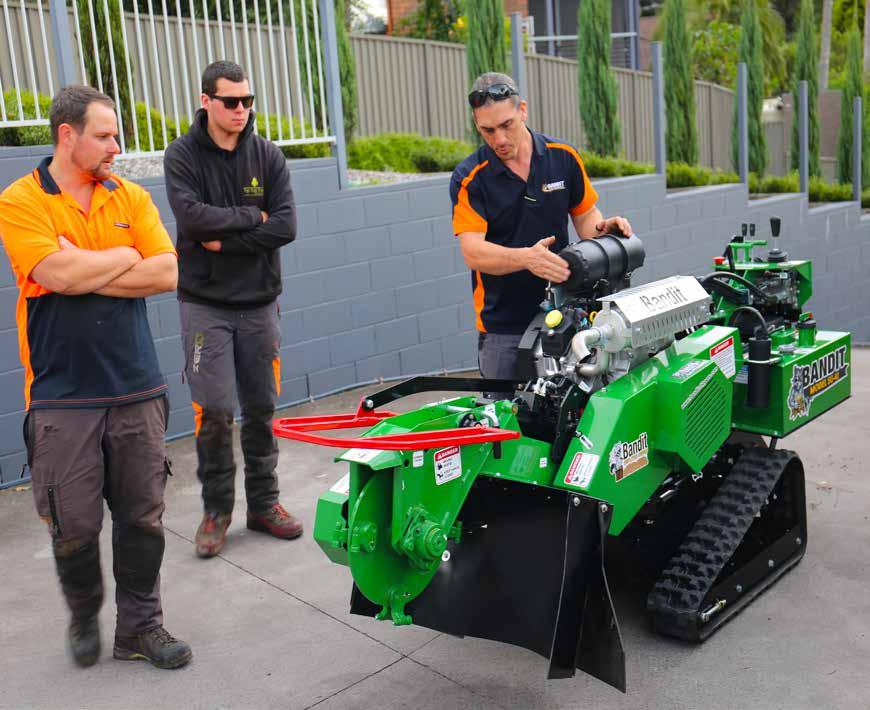
VIC/TAS
Bandit Tree Equipment (03) 9801 5066 www.banditchippers.com.au